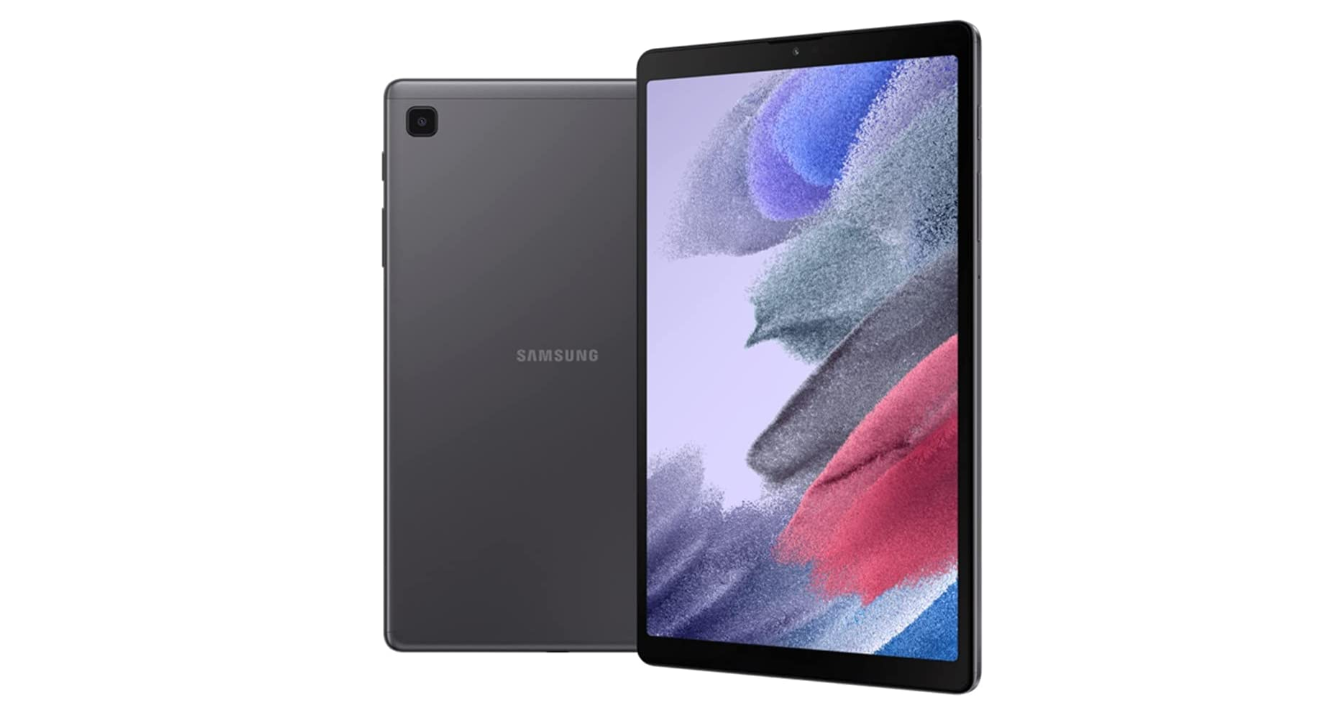Samsung Galaxy Tab A7 Lite User Manual

Getting started
![]()
Device layout and functions
► SM-T225, SM-T225N:
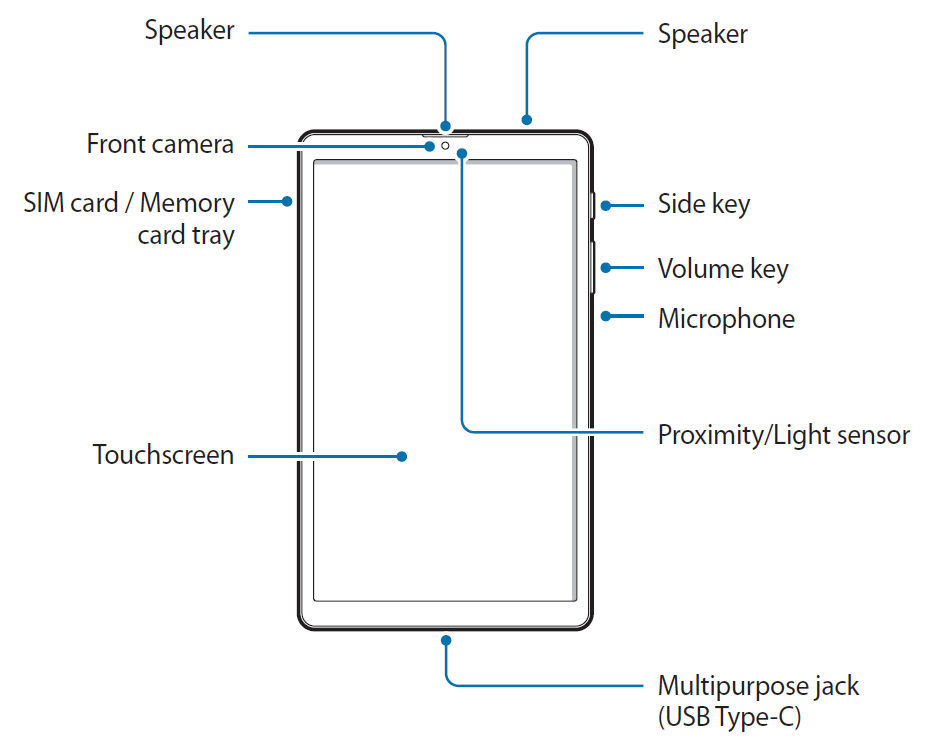
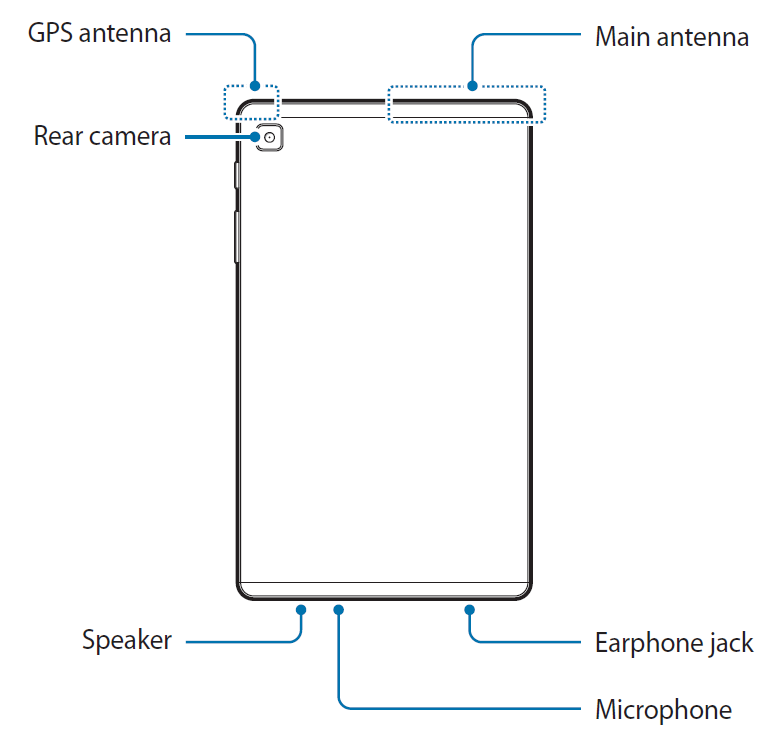
► SM-T220, SM-T227:
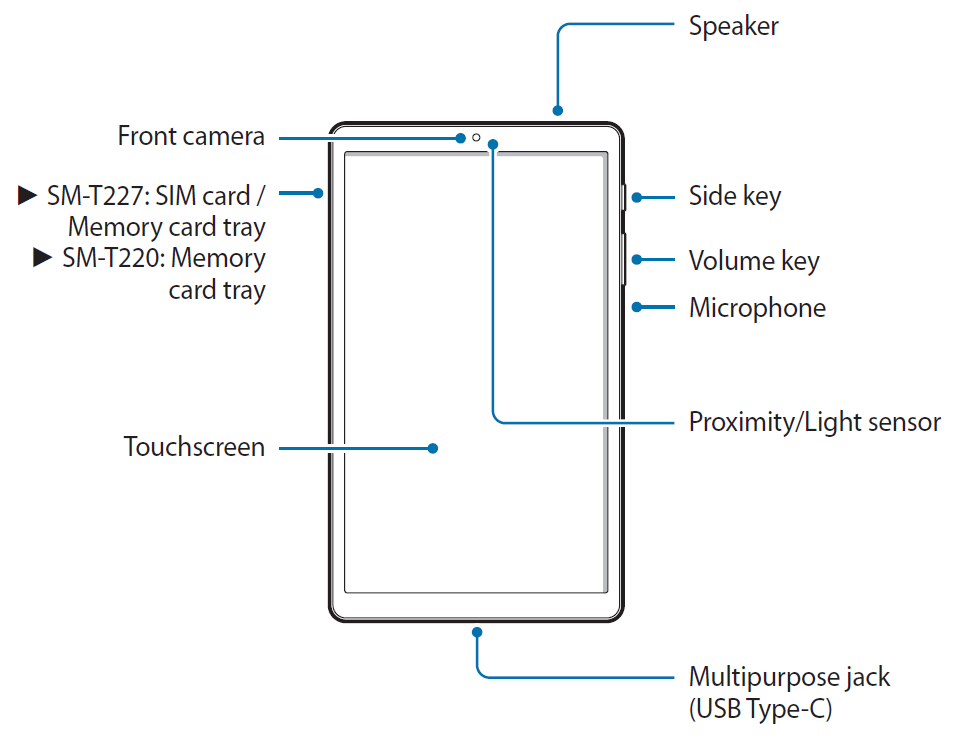

![]()
- When using the speakers, such as when playing media files or using speakerphone, do not place the device close to your ears.
- Be careful not to expose the camera lens to a strong light source, such as direct sunlight. If the camera lens is exposed to a strong light source, such as direct sunlight, the camera image sensor may be damaged. A damaged image sensor is irreparable and will cause dots or spots in pictures.
- If you use the device with its glass or acrylic body broken, there may be a risk of injury. Use the device only after it has been repaired at a Samsung Service Centre.
- If dust or foreign materials enter the microphone, speaker, or receiver, the device’s sound may become quiet or certain features may not work. If you attempt to remove the dust or foreign materials with a sharp object, the device may be damaged and its appearance may be affected.
![]()
- Connectivity problems and battery drain may occur in the following situations:
– If you attach metallic stickers on the antenna area of the device
– If you attach a device cover made with metallic material to the device
– If you cover the device’s antenna area with your hands or other objects while using certain features, such as calls or the mobile data connection - Using a Samsung-approved screen protector is recommended. Unapproved screen protectors may cause the sensors to malfunction.
- Do not cover the proximity/light sensor area with screen accessories, such as a screen protector, stickers, or a cover. Doing so may cause the sensor to malfunction.
- Do not allow water to contact the touchscreen. The touchscreen may malfunction in humid conditions or when exposed to water.
Hard keys

Setting the Side key
Select an app or feature to launch by pressing the Side key twice.
Launch the Settings app, tap Advanced features → Side key, and then select an option you want.
Soft buttons

When you turn on the screen, the soft buttons will appear at the bottom of the screen. Refer to Navigation bar (soft buttons) for more information.
Charging the battery
Charge the battery before using it for the first time or when it has been unused for extended periods.
![]()
Use only Samsung-approved battery, charger, and cable specifically designed for your device. Incompatible battery, charger, and cable can cause serious injuries or damage to your device.
![]()
- Connecting the charger improperly may cause serious damage to the device. Any damage caused by misuse is not covered by the warranty.
- Use only USB Type-C cable supplied with the device. The device may be damaged if you use Micro USB cable.
![]()
To save energy, unplug the charger when not in use. The charger does not have a power switch, so you must unplug the charger from the electric socket when not in use to avoid wasting power. The charger should remain close to the electric socket and easily accessible while charging.
Wired charging
Connect the USB cable to the USB power adaptor and plug the cable into the device’s multipurpose jack to charge the battery. After fully charging, disconnect the charger from the device.
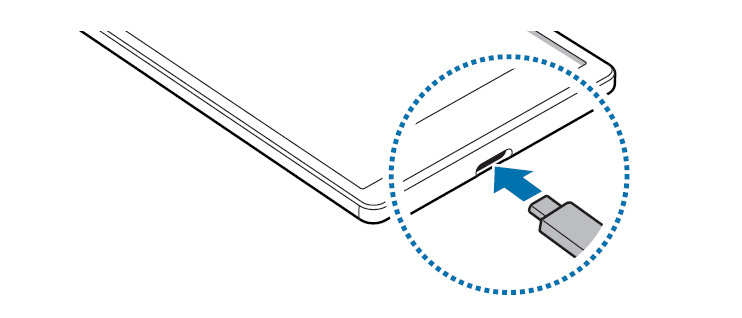
Quick charging
Launch the Settings app, tap Battery and device care → Battery → More battery settings, and then activate the feature you want.
- Fast charging: To use the fast charging feature, use a battery charger that supports Adaptive fast charging.
![]() You can charge the battery more quickly while the device or its screen is turned off.
You can charge the battery more quickly while the device or its screen is turned off.
Reducing the battery consumption
Your device provides various options that help you conserve battery power.
- Optimise the device using the device care feature.
- When you are not using the device, turn off the screen by pressing the Side key.
- Activate power saving mode.
- Close unnecessary apps.
- Deactivate the Bluetooth feature when not in use.
- Deactivate auto-syncing of apps that need to be synced.
- Decrease the backlight time.
- Decrease the screen brightness.
Battery charging tips and precautions
- If the battery is completely discharged, the device cannot be turned on immediately when the charger is connected. Allow a depleted battery to charge for a few minutes before turning on the device.
- If you use multiple apps at once, network apps, or apps that need a connection to another device, the battery will drain quickly. To avoid losing power during a data transfer, always use these apps after fully charging the battery.
- Using a power source other than the charger, such as a computer, may result in a slower charging speed due to a lower electric current.
- The device can be used while it is charging, but it may take longer to fully charge the battery.
- If the device receives an unstable power supply while charging, the touchscreen may not function. If this happens, unplug the charger from the device.
- While charging, the device and the charger may heat up. This is normal and should not affect the device’s lifespan or performance. If the battery gets hotter than usual, the charger may stop charging.
- If you charge the device while the multipurpose jack is wet, the device may be damaged. Thoroughly dry the multipurpose jack before charging the device.
- If the device is not charging properly, take the device and the charger to a Samsung Service Centre.
SIM or USIM card (nano-SIM card) (Mobile network enabled models)
Insert the SIM or USIM card provided by the mobile telephone service provider. Some services that require a network connection may not be available depending on the service provider.
Installing the SIM or USIM card

- Insert the ejection pin into the hole on the tray to loosen the tray.
- Pull out the tray gently from the tray slot.
- Place the SIM or USIM card on the tray with the gold-colored contacts facing downwards and gently press the SIM or USIM card into the tray to secure it.
- Insert the tray back into the tray slot.
![]()
- Use only a nano-SIM card.
- Use caution not to lose or let others use the SIM or USIM card. Samsung is not responsible for any damages or inconveniences caused by lost or stolen cards.
- Ensure that the ejection pin is perpendicular to the hole. Otherwise, the device may be damaged.
- If the card is not fixed firmly into the tray, the SIM card may leave or fall out of the tray.
- If you insert the tray into your device while the tray is wet, your device may be damaged. Always make sure the tray is dry.
- Fully insert the tray into the tray slot to prevent liquid from entering your device.
Memory card (microSD card)
Installing a memory card
Your device’s memory card capacity may vary from other models and some memory cards may not be compatible with your device depending on the memory card manufacturer and type. To view your device’s maximum memory card capacity, refer to the Samsung website.

- Insert the ejection pin into the hole on the tray to loosen the tray.
- Pull out the tray gently from the tray slot.
- Place a memory card on the tray with the gold-colored contacts facing downwards and gently press the memory card into the tray to secure it.
- Insert the tray back into the tray slot.
![]()
- Some memory cards may not be fully compatible with the device. Using an incompatible card may damage the device or the memory card, or corrupt the data stored in it.
- Use caution to insert the memory card right-side up.
- Ensure that the ejection pin is perpendicular to the hole. Otherwise, the device may be damaged.
- When you remove the tray from the device, the mobile data connection will be disabled.
- If the card is not fixed firmly into the tray, the memory card may leave or fall out of the tray.
- If you insert the tray into your device while the tray is wet, your device may be damaged. Always make sure the tray is dry.
- Fully insert the tray into the tray slot to prevent liquid from entering your device.
![]()
- The device supports the FAT32, the exFAT, and the ext4 file systems for memory cards. When inserting a card formatted in a different file system, the device will ask to reformat the card or will not recognise the card. To use the memory card, you must format it. If your device cannot format or recognise the memory card, contact the memory card manufacturer or a Samsung Service Centre.
- Frequent writing and erasing of data shortens the lifespan of memory cards.
- When inserting a memory card into the device, the memory card’s file directory appears in the My Files → SD card folder.
Removing the memory card
Before removing the memory card, first unmount it for safe removal.
- Launch the Settings app and tap Battery and device care → Storage.
- Swipe to the left to view the SD card page.
- Tap
 → Unmount.
→ Unmount.
![]()
Do not remove external storage, such as a memory card or USB storage, while the device is transferring or accessing information, or right after transferring data. Doing so can cause data to be corrupted or lost or cause damage to the external storage or device. Samsung is not responsible for losses, including loss of data, resulting from the misuse of external storage devices.
Formatting the memory card
A memory card formatted on a computer may not be compatible with the device. Format the memory card on the device.
- Launch the Settings app and tap Battery and device care → Storage.
- Swipe to the left to view the SD card page.
- Tap
 → Format.
→ Format.
Before formatting the memory card, remember to make backup copies of all important data stored in the memory card. The manufacturer’s warranty does not cover loss of data resulting from user actions.
Turning the device on and off
![]()
Follow all posted warnings and directions from authorised personnel in areas where the use of wireless devices is restricted, such as aeroplanes and hospitals.
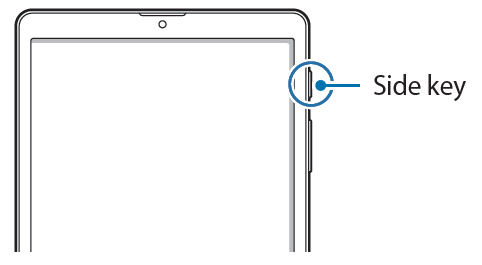
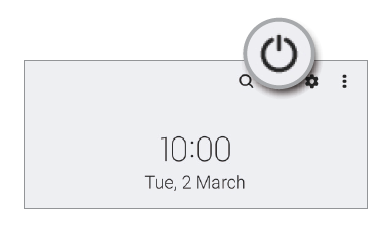
Turning the device on
Press and hold the Side key for a few seconds to turn on the device.
Turning the device off
- To turn off the device, press and hold the Side key. Alternatively, open the notification panel, swipe downwards, and then tap
 .
. - Tap Power off.
To restart the device, tap Restart.
Forcing restart
If your device is frozen and unresponsive, press and hold the Side key and the Volume Down key simultaneously for more than 7 seconds to restart it.
Initial setup
When you turn on your device for the first time or after performing a data reset, follow the on-screen instructions to set up your device.
![]() If you do not connect to a Wi-Fi network, you may not be able to set up some device features during the initial setup.
If you do not connect to a Wi-Fi network, you may not be able to set up some device features during the initial setup.
Apps and features
Introduction
Use apps and various features of the device.
This chapter is a common manual for apps and features provided by Samsung devices.
Depending on the model, some content may differ, or descriptions of apps or features not available on your device may be included.
![]()
Samsung account
Your Samsung account is an integrated account service that allows you to use a variety of Samsung services provided by mobile devices, TVs, and the Samsung website.
To check the list of services that can be used with your Samsung account, visit account.samsung.com.
- Launch the Settings app and tap Samsung account.
Alternatively, launch the Settings app and tap Accounts and backup → Manage accounts → Add account → Samsung account. - Sign in to your Samsung account. If you do not have a Samsung account, tap Create account.
Finding your ID and resetting your password
If you forget your Samsung account ID or password, tap Find ID or Forgot password? on the Samsung account sign-in screen. You can find your ID or reset your password after you enter the required information.
Signing out of your Samsung account
When you sign out of your Samsung account, your data, such as contacts or events, will also be removed from your device.
- Launch the Settings app and tap Accounts and backup → Manage accounts.
- Tap Samsung account → My profile and tap Sign out at the bottom of the screen.
- Tap Sign out, enter your Samsung account password, and then tap OK.
Understanding the screen
Controlling the touchscreen
Tapping
Tap the screen.
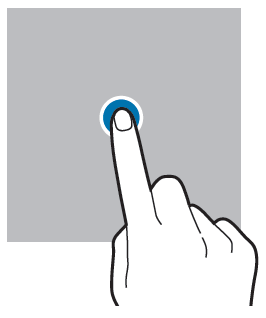
Dragging
Tap and hold an item and drag it to the target position.

Swiping
Swipe upwards, downwards, to the left, or to the right.
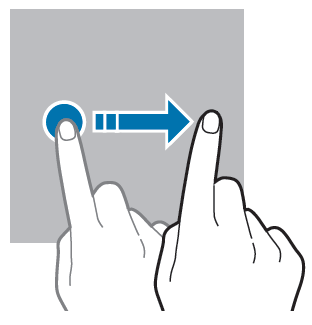
Tapping and holding
Tap and hold the screen for approximately 2 seconds.

Double-tapping
Double-tap the screen.

Spreading and pinching
Spread two fingers apart or pinch on the screen.

![]()
- Do not allow the touchscreen to come into contact with other electrical devices. Electrostatic discharges can cause the touchscreen to malfunction.
- To avoid damaging the touchscreen, do not tap it with anything sharp or apply excessive pressure to it with your fingertips.
- It is recommended not to use fixed graphics on part or all of the touchscreen for extended periods. Doing so may result in afterimages (screen burn-in) or ghosting.
![]()
The device may not recognize touch inputs close to the edges of the screen, which are outside of the touch input area.
Navigation bar (soft buttons)
When you turn on the screen, the soft buttons will appear on the navigation bar at the bottom of the screen. The soft buttons are set to the Recents button, Home button, and Back button by default. The functions of the buttons can change according to the app currently being used or usage environment.
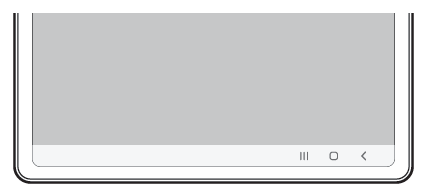

Hiding the navigation bar
View files or use apps on a wider screen by hiding the navigation bar.
Launch the Settings app, tap Display → Navigation bar, and then tap Swipe gestures under Navigation type. The navigation bar will be hidden and the gesture hints will appear. Tap More options and select an option you want.

If you want to hide the gesture hints at the bottom of the screen, tap the Gesture hint switch to deactivate it.
Home screen and Apps screen
The Home screen is the starting point for accessing all of the device’s features. It displays widgets, shortcuts to apps, and more.
The Apps screen displays icons for all apps, including newly installed apps.
Switching between Home and Apps screens
On the Home screen, swipe upwards to open the Apps screen.
To return to the Home screen, swipe upwards or downwards on the Apps screen. Alternatively, tap the Home button or the Back button.
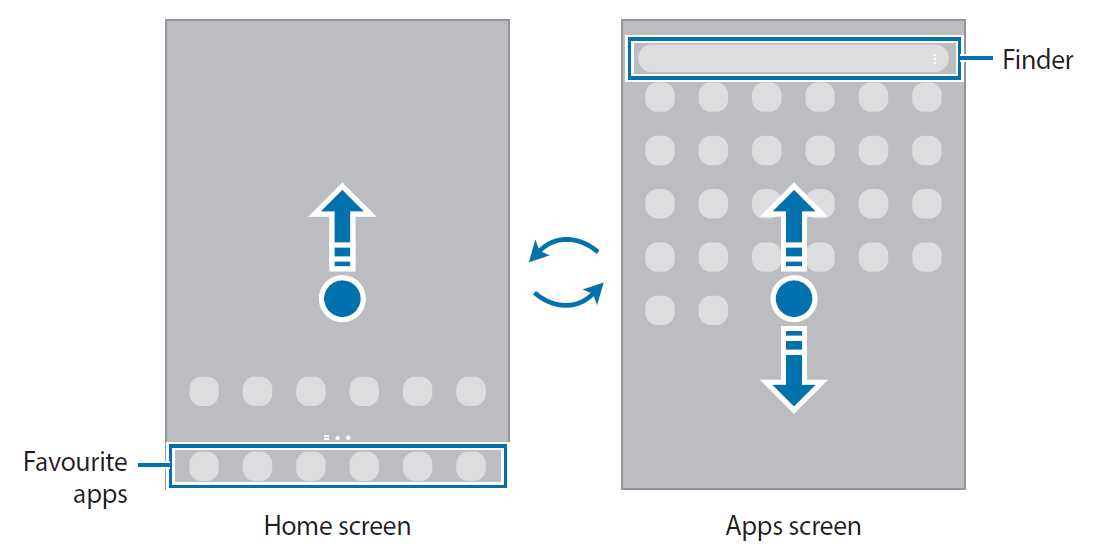
If you add the Apps button on the Home screen, you can open the Apps screen by tapping the button. On the Home screen, tap and hold an empty area, tap Settings, and then tap the Show Apps screen button on Home screen switch to activate it. The Apps button will be added at the bottom of the Home screen.

Editing the Home screen
On the Home screen, tap and hold an empty area, or pinch your fingers together to access the editing options. You can set the wallpaper, add widgets, and more. You can also add, delete, or rearrange Home screen panels.
- Adding panels: Swipe to the left, and then tap
 .
. - Moving panels: Tap and hold a panel preview, and then drag it to a new location.
- Deleting panels: Tap
 on the panel.
on the panel.
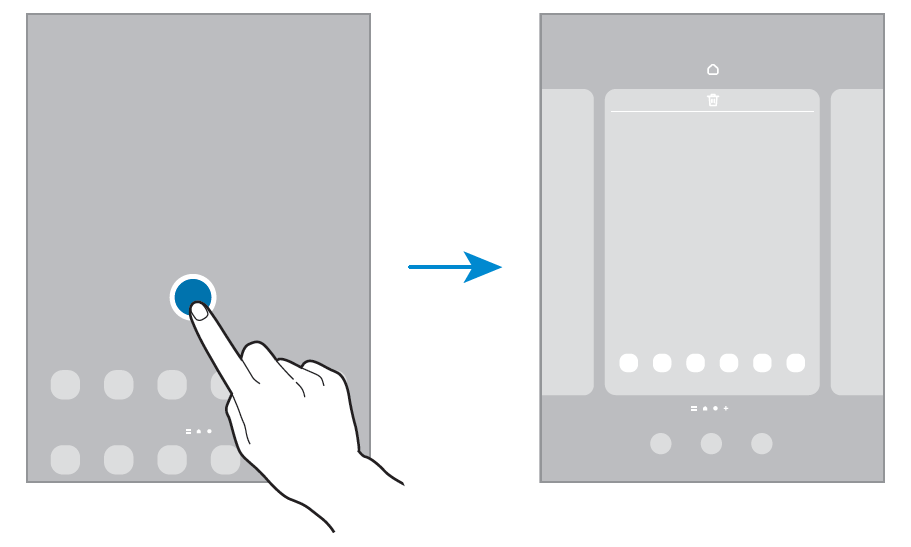
- Wallpaper and style: Change the wallpaper settings for the Home screen and the locked screen.
- Widgets: Widgets are small apps that launch specific app functions to provide information and convenient access on your Home screen. Select a widget and tap Add. The widget will be added on the Home screen.
- Settings: Configure settings for the Home screen, such as the screen layout.
Displaying all apps on the Home screen
Without using a separate Apps screen, you can set the device to display all apps on the Home screen. On the Home screen, tap and hold an empty area, and then tap Settings → Home screen layout → Home screen only → Apply.
You can now access all your apps by swiping to the left on the Home screen.
Launching Finder
Search for content on the device quickly.
- On the Apps screen, tap Search. Alternatively, open the notification panel, swipe downwards, and then tap
 .
. - Enter a keyword.
Apps and content on your device will be searched.
If you tap on the keyboard, you can search for more content .
.
Moving items
Tap and hold an item, and then drag it to a new location. To move the item to another panel, drag it to the side of the screen.
To add a shortcut to an app on the Home screen, tap and hold an item on the Apps screen, and then tap Add to Home. A shortcut to the app will be added on the Home screen.
You can also move frequently used apps to the shortcuts area at the bottom of the Home screen.
Creating folders
Create folders and gather similar apps to quickly access and launch apps.
On the Home screen or the Apps screen, tap and hold an app, and then drag it over another app.
A new folder containing the selected apps will be created. Tap Folder name and enter a folder name.
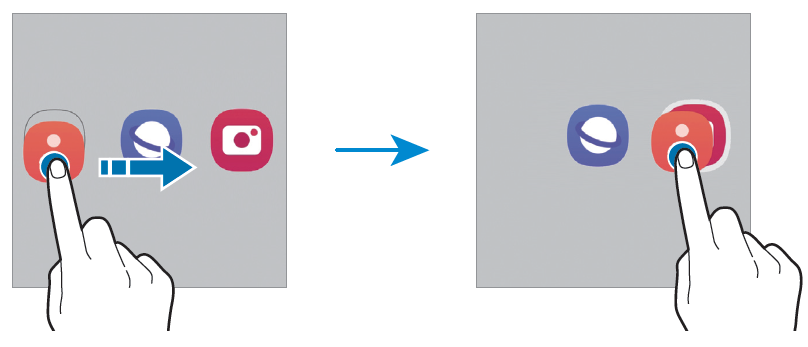
- Adding more apps
Tap on the folder. Tick the apps to add and tap Done. You can also add an app by dragging it to the folder.
on the folder. Tick the apps to add and tap Done. You can also add an app by dragging it to the folder. - Moving apps from a folder
Tap and hold an app to drag it to a new location. - Deleting a folder
Tap and hold a folder, and then tap Delete folder. Only the folder will be deleted. The folder’s apps will be relocated to the Apps screen.
Taskbar
The taskbar appears at the bottom of screen while using an app. The favourite apps from the bottom of the Home screen, recently used apps, and the all apps button will be displayed on the taskbar. You can switch apps quickly by selecting the app you want from the taskbar.
You can also run multiple apps at the same time. While using an app, tap and hold the app you want from the taskbar, drag it upwards, and then drop it wherever you want.
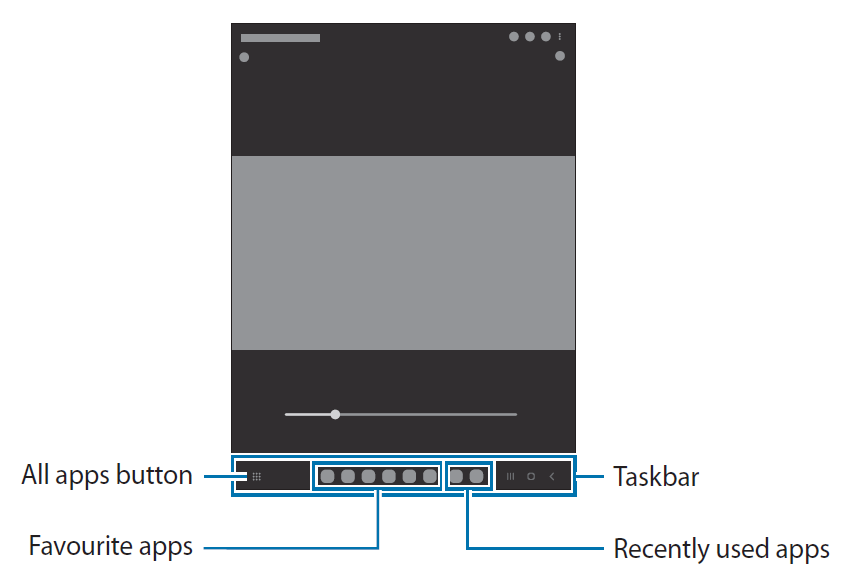
![]() If you do not want to use the taskbar, launch the Settings app, tap Display, and then tap the Taskbar switch to deactivate it.
If you do not want to use the taskbar, launch the Settings app, tap Display, and then tap the Taskbar switch to deactivate it.
Edge panel
You can quickly access your favourite apps and features from the Edge panels.
Drag the Edge panel handle towards the centre of the screen.
If the Edge panel handle is not visible, launch the Settings app, tap Display, and then tap the Edge panels switch to activate it.

Lock screen
Pressing the Side key turns off the screen and locks it. Also, the screen turns off and automatically locks if the device is not used for a specified period.
To unlock the screen, swipe in any direction when the screen turns on.
If the screen is off, press the Side key to turn on the screen. Alternatively, double-tap the screen.
Changing the screen lock method
To change the screen lock method, launch the Settings app, tap Lock screen → Screen lock type, and then select a method.
When you set a pattern, PIN, password, or your biometric data for the screen lock method, you can protect your personal information by preventing others from accessing your device. After setting the screen lock method, the device will require an unlock code whenever unlocking it.
![]()
You can set your device to perform a factory data reset if you enter the unlock code incorrectly several times in a row and reach the attempt limit. Launch the Settings app, tap Lock screen → Secure lock settings, unlock the screen using the preset screen lock method, and then tap the Auto factory reset switch to activate it.
Indicator icons
Indicator icons appear on the status bar at the top of the screen. The icons listed in the table below are most common.
![]()
![]()
![]()
- The status bar may not appear at the top of the screen in some apps. To display the status bar, drag down from the top of the screen.
- Some indicator icons appear only when you open the notification panel.
- The indicator icons may appear differently depending on the service provider or model.
Notification panel
When you receive new notifications, indicator icons appear on the status bar. To see more information about the icons, open the notification panel and view the details.
To open the notification panel, drag the status bar downwards. To close the notification panel, swipe upwards on the screen.
You can use the following functions on the notification panel.
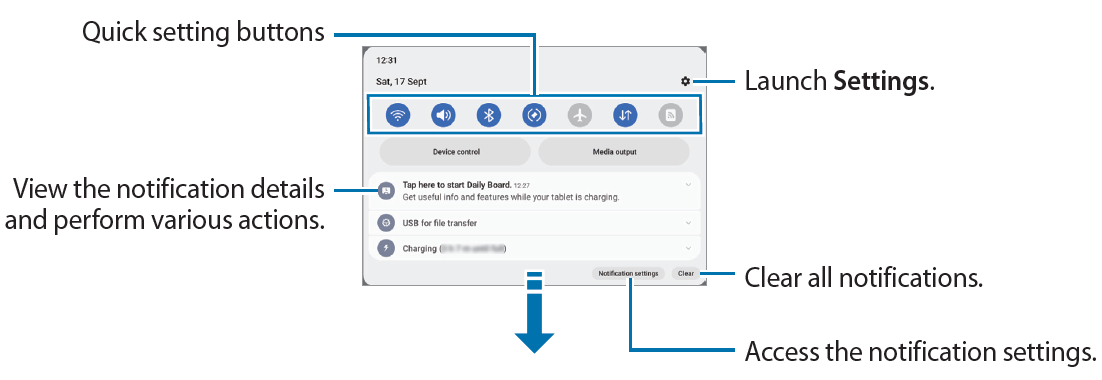
Using quick setting buttons
Tap quick setting buttons to activate certain features. Swipe downwards on the notification panel to view more buttons. To add more buttons, tap ![]() .
.
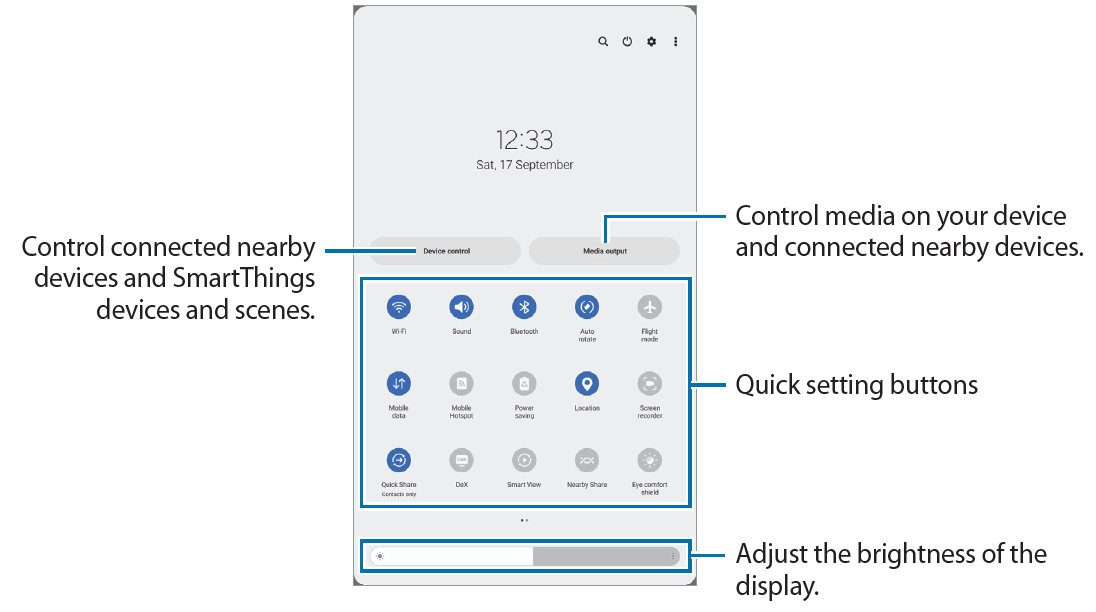
To change feature settings, tap the text under each button. To view more detailed settings, tap and hold a button.
To rearrange buttons, tap![]() → Edit buttons, tap and hold a button, and then drag it to another location.
→ Edit buttons, tap and hold a button, and then drag it to another location.
Controlling media playback
Take control of music or video playback easily using the Media feature.
- Open the notification panel, swipe downwards, and then tap Media output.
- Tap the icons on the controller to control the playback.
Controlling nearby devices
Launch quickly and take control of nearby connected devices and frequently used SmartThings devices and scenes on the notification panel.
- Open the notification panel, swipe downwards, and then tap Device control.
Nearby connected devices and SmartThings devices and scenes will appear. - Select a nearby device or a SmartThings device to control it, or select a scene to launch it.
Entering text
Keyboard layout
A keyboard appears automatically when you enter text.

![]() Text entry is not supported in some languages. To enter text, you must change the input language to one of the supported languages.
Text entry is not supported in some languages. To enter text, you must change the input language to one of the supported languages.
Changing the input language
Tap ![]() → Languages and types → Manage input languages and select the languages to use. When you select two or more languages, you can switch between the input languages by tapping
→ Languages and types → Manage input languages and select the languages to use. When you select two or more languages, you can switch between the input languages by tapping ![]() .
.
Changing the keyboard
On the navigation bar, tap![]() to change the keyboard.
to change the keyboard.
To change the keyboard type, tap ![]() → Languages and types, select a language, and then select the keyboard type you want.
→ Languages and types, select a language, and then select the keyboard type you want.
![]()
If the keyboard button (![]() ) does not appear on the navigation bar, launch the Settings app, tap General management → Keyboard list and default, and then tap the Keyboard button on navigation bar switch to activate it.
) does not appear on the navigation bar, launch the Settings app, tap General management → Keyboard list and default, and then tap the Keyboard button on navigation bar switch to activate it.
Copying and pasting
- Tap and hold over text.
- Drag
 or
or to select the desired text, or tap Select all to select all text.
to select the desired text, or tap Select all to select all text. - Tap Copy or Cut.
The selected text is copied to the clipboard. - Tap and hold where the text is to be inserted and tap Paste.
To paste text that you have previously copied, tap Clipboard and select the text.
Installing or uninstalling apps
Galaxy Store
Purchase and download apps. You can download apps that are specialised for Samsung Galaxy devices.
Launch the Galaxy Store app. Browse apps by category or tap![]() to search for a keyword.
to search for a keyword.
![]()
- This app may not be available depending on the service provider or model.
- To change the auto update settings, tap Menu →
 → Auto update apps, and then select an option.
→ Auto update apps, and then select an option.
Play Store
Purchase and download apps.
Launch the Play Store app. Browse apps by category or search for apps by keyword.
![]()
To change the auto update settings, tap your account icon, tap Settings → Network preferences → Auto-update apps, and then select an option.
Managing apps
Uninstalling or disabling apps
Tap and hold an app and select an option.
- Uninstall: Uninstall downloaded apps.
- Disable: Disable selected default apps that cannot be uninstalled from the device.
![]() Some apps may not support this feature.
Some apps may not support this feature.
Enabling apps
Launch the Settings app, tap Apps → ![]() → Disabled → OK, select an app, and then tap Enable.
→ Disabled → OK, select an app, and then tap Enable.
Setting app permissions
For some apps to operate properly, they may need permission to access or use information on your device.
To view your app permission settings, launch the Settings app and tap Apps. Select an app and tap Permissions. You can view the app’s permissions list and change its permissions.
To view or change app permission settings by permission category, launch the Settings app and tap Apps → ![]() → Permission manager. Select an item and select an app.
→ Permission manager. Select an item and select an app.
![]() If you do not grant permissions to apps, the basic features of the apps may not function properly.
If you do not grant permissions to apps, the basic features of the apps may not function properly.
Phone
Introduction
Make or answer voice and video calls.
![]()
The Call & text on other devices feature allows you to use calling and messaging features on your tablet with your smartphone number. On your tablet and smartphone, launch the Settings app, tap Connected devices, and then tap the Call & text on other devices switch to activate it. You must register and sign in to the same Samsung account on the tablet and smartphone. Some calling and messaging features may not be available.
Making calls
- Launch the Phone app and tap Keypad.
- Enter a phone number.
- Tap
 to make a voice call, or tap
to make a voice call, or tap  or
or  to make a video call.
to make a video call.
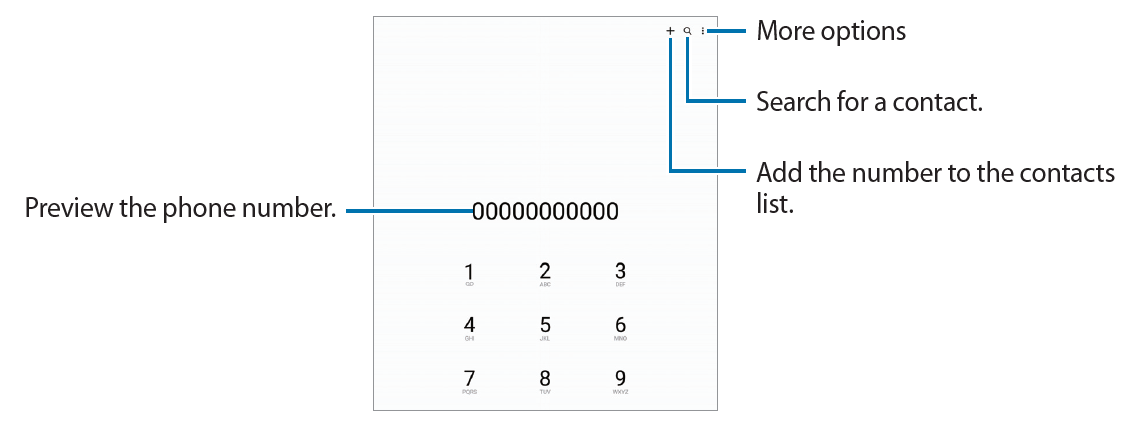
Making calls from call logs or contacts list
Launch the Phone app, tap Recents or Contacts, and then swipe to the right on a contact or a phone number to make a call.
If this feature is deactivated, tap ![]() → Settings → Other call settings, and then tap the Swipe to call or text switch to activate it.
→ Settings → Other call settings, and then tap the Swipe to call or text switch to activate it.
Using speed dial
To set a number to speed dial, launch the Phone app, tap Keypad → → Speed dial numbers, select a speed dial number, and then add a phone number.
To make a call, tap and hold a speed dial number on the keypad. For speed dial numbers 10 and up, tap the first digit(s) of the number, and then tap and hold the last digit.
For example, if you set the number 123 as a speed dial number, tap 1, tap 2, and then tap and hold 3.
Making an international call
1 Launch the Phone app and tap Keypad.
2 Tap and hold 0 until the + sign appears.
3 Enter the country code, area code, and phone number, and then tap ![]() .
.
Receiving calls
Answering a call
When a call comes in, drag ![]() outside the large circle.
outside the large circle.
Rejecting a call
When a call comes in, ![]() drag outside the large circle.
drag outside the large circle.
To send a message when rejecting an incoming call, drag the Send message bar upwards and select a message to send.
To create various rejection messages, launch the Phone app, tap ![]() → Settings → Quick decline messages, enter a message, and then tap
→ Settings → Quick decline messages, enter a message, and then tap ![]() .
.
Blocking phone numbers
Block calls from specific numbers added to your block list.
- Launch the Phone app and tap
 → Settings → Block numbers.
→ Settings → Block numbers. - Tap Recents or Contacts, select contacts or phone numbers, and then tap Done.
To manually enter a number, tap Add phone number, enter a phone number, and then tap .
.
When blocked numbers try to contact you, you will not receive notifications. The calls will be logged in the call log.
![]()
You can also block incoming calls from people that do not show their caller ID. Tap the Block calls from unknown numbers switch to activate the feature.
Contacts
Introduction
Create new contacts or manage contacts on the device.
Adding contacts
Creating a new contact
- Launch the Contacts app and tap
 .
. - Select a storage location.
- Enter contact information and tap Save.
Importing contacts
Add contacts by importing them from other storages to your device.
- Launch the Contacts app and tap
 → Manage contacts → Import contacts.
→ Manage contacts → Import contacts. - Follow the on-screen instructions to import contacts.
Syncing contacts with your web accounts
Sync your device contacts with online contacts saved in your web accounts, such as your Samsung account.
- Launch the Settings app, tap Accounts and backup → Manage accounts and select the account to sync with.
- Tap Sync account and tap the Contacts switch to activate it.
Searching for contacts
Launch the Contacts app. Tap at the top of the contacts list and enter search criteria.
Tap the contact. Then take one of the following actions:
 : Make a voice call.
: Make a voice call. /
/  : Make a video call.
: Make a video call. : Compose a message.
: Compose a message. : Compose an email.
: Compose an email.
Deleting contacts
- Launch the Contacts app and tap
 → Edit.
→ Edit. - Select contacts and tap Delete.
To delete contacts one by one, tap a contact from the contacts list and tap More → Delete.
Sharing contacts
You can share contacts with others by using various sharing options.
- Launch the Contacts app and tap
 → Edit.
→ Edit. - Select contacts and tap Share.
- Select a sharing method.
Creating groups
You can add groups, such as family or friends, and manage contacts by group.
- Launch the Contacts app and tap
 → Groups → Create group.
→ Groups → Create group. - Follow the on-screen instructions to create a group.
Merging duplicate contacts
If your contacts list includes duplicate contacts, merge them into one to streamline your contacts list.
- Launch the Contacts app and tap
 → Manage contacts → Merge contacts.
→ Manage contacts → Merge contacts. - Tick contacts and tap Merge.
Messages
Introduction
Send and view messages by conversation.
You may incur additional charges for sending or receiving messages when you are roaming.
![]()
The Call & text on other devices feature allows you to use calling and messaging features on your tablet with your smartphone number. On your tablet and smartphone, launch the Settings app, tap Connected devices, and then tap the Call & text on other devices switch to activate it. You must register and sign in to the same Samsung account on the tablet and smartphone. Some calling and messaging features may not be available.
Sending messages
- Launch the Messages app and tap
 .
. - Add recipients and enter a message.
To record and send a voice message, tap and hold , say your message, and then release your finger. The recording icon appears only while the message input field is empty.
, say your message, and then release your finger. The recording icon appears only while the message input field is empty. - Tap
 to send the message.
to send the message.

Viewing messages
- Launch the Messages app and tap Conversations.
- On the messages list, select a contact or a phone number.
• To reply to the message, tap the message input field, enter a message, and then tap .
.
• To adjust the font size, spread two fingers apart or pinch on the screen.
Sorting messages
You can sort messages by category and manage them easily.
Launch the Messages app and tap Conversations → ![]() .
.
If the category option does not appear, tap at the top of the messages list, tap Settings, and then tap the Conversation categories switch to activate it.
Deleting messages
Tap and hold a message to delete, then tap Delete.
Changing message settings
Launch the Messages app, tap ![]() at the top of the messages list and tap Settings. You can block unwanted messages, change notification settings, and more.
at the top of the messages list and tap Settings. You can block unwanted messages, change notification settings, and more.
Internet
Browse the Internet to search for information and bookmark your favourite webpages to access them conveniently.
- Launch the Internet app.
- Enter the web address or a keyword, and then tap Go.
To view the toolbars, drag your finger downwards slightly on the screen.
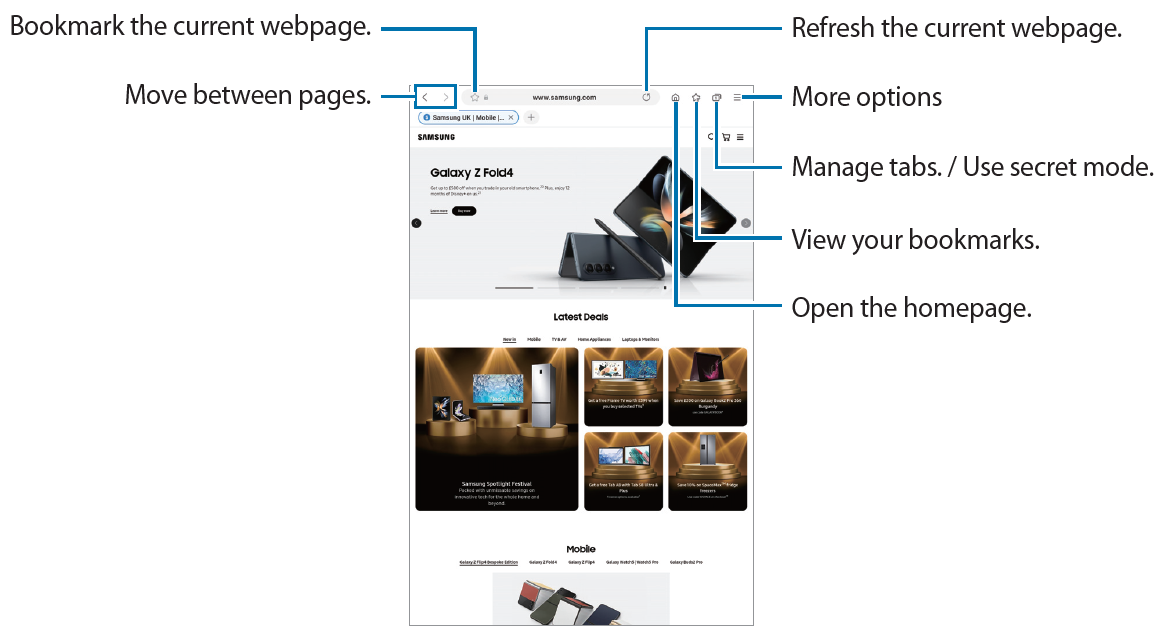
Using secret mode
If you set a password for secret mode, you can prevent others from viewing your search history, browsing history, bookmarks, and saved pages.
- Tap
 → Turn on Secret mode.
→ Turn on Secret mode. - Tap the Lock Secret mode switch to activate it, tap Start, and then set a password for secret mode.
In secret mode, the device will change the colour of the toolbars. To deactivate secret mode, tap → Turn off Secret mode.
→ Turn off Secret mode.
![]() In secret mode, you cannot use some features, such as screen capture.
In secret mode, you cannot use some features, such as screen capture.
Multi window
Introduction
Multi window lets you run up to three apps at the same time in the split screen view. You can also run multiple apps at the same time in the pop-up view.

![]() Some apps may not support this feature.
Some apps may not support this feature.
Split screen view
- Tap the Recents button to open the list of recently used apps.
- Swipe to the left or right, tap an app’s icon, and then tap Open in split screen view.
- On the apps list, select another app to launch.
Launching apps from the Edge panel
- While using an app, drag the Edge panel handle towards the centre of the screen.
- Tap and hold an app, drag it to the left, and then drop it where Drop here to open appears.
The selected app will launch in the split screen view.
![]()
You can set to launch an app in the split screen view by tapping it once. Tap → and tap Tap under Open in split screen view. If you tap the Show recent apps switch to activate it, you can launch the recently used apps in the split screen view from the Edge panel.
Adding app pairs
Add frequently used apps as an app pair to launch them together in the split screen view with a single tap.
- In the split screen view, tap the circles between the app windows.
- Tap
 .
. - Select a location to add the app pair.
The apps you are using in the split screen view will be saved to the location you select as an app pair.
Adjusting the window size
Drag the circles between the app windows to adjust the size of the windows.
When you drag the circles between the app windows to the edge of the screen, the window will be maximized.
Pop-up view
- Tap the Recents button to open the list of recently used apps.
- Swipe to the left or right, tap an app’s icon, and then tap Open in pop-up view.
The app screen will appear in the pop-up view.
If you tap the Home button while using a pop-up window, the window will be minimized and displayed as an app icon. To use the pop-up window again, tap the app icon.
Launching apps from the Edge panel
- Drag the Edge panel handle toward the center of the screen.
- Tap and hold an app, drag it to the left, and then drop it where Drop here for pop-up view appears.
The selected app will launch in the pop-up view.
Moving pop-up windows
To move a pop-up window, tap the window’s toolbar and drag it to a new location.
Samsung Kids
You can restrict children’s access to certain apps, set their usage times, and configure settings to provide a fun and safe environment for children when they use the device.
Open the notification panel, swipe downwards, and then tap ![]() (Kids) to activate it. If you cannot find
(Kids) to activate it. If you cannot find ![]() (Kids) on the quick panel, tap
(Kids) on the quick panel, tap ![]() and drag the button over to add it. When starting Samsung Kids for the first time or after performing a data reset, follow the on-screen instructions to complete the setup.
and drag the button over to add it. When starting Samsung Kids for the first time or after performing a data reset, follow the on-screen instructions to complete the setup.
On the Samsung Kids screen, select the app you want to use.
![]() Your preset screen lock method or your created PIN will be used when activating the Parental controls feature or closing Samsung Kids.
Your preset screen lock method or your created PIN will be used when activating the Parental controls feature or closing Samsung Kids.
Using parental control features
You can configure the settings for Samsung Kids and view the usage history.
On the Samsung Kids screen, tap ![]() → Parental controls and enter your unlock code.
→ Parental controls and enter your unlock code.
Closing Samsung Kids
To close Samsung Kids, tap the Back button or tap ![]() → Close Samsung Kids, and then enter your unlock code.
→ Close Samsung Kids, and then enter your unlock code.
Samsung Notes
Create notes by entering text from the keyboard or by handwriting or drawing on the screen. You can also insert images or voice recordings into your notes.
Creating notes
- Launch the Samsung Notes app, tap
 , and then create a note.
, and then create a note. 
- When you are finished composing the note, tap the Back button to save it.
If you want to save the note in another file format, tap → Save as file.
→ Save as file.
Deleting notes
Tap and hold a note to delete and tap Delete.
Samsung Members
Samsung Members offers support services to customers, such as device problem diagnosis, and lets users submit questions and error reports. You can also share information with others in the Galaxy users’ community or view the latest news and tips. Samsung Members can help you solve any problems you might encounter while using your device.
Galaxy Shop
Access the Samsung website and view various information related to products.
Launch the Galaxy Shop app.
![]()
- This app may not be available depending on the service provider or model.
- This app may be named Samsung Shop depending on the region.
Calendar
Manage your schedule by entering upcoming events in your planner.
Creating events
- Launch the Calendar app and tap
 or double-tap a date.
or double-tap a date.
If the date already has saved events or tasks in it, tap the date and tap .
. - Enter event details and tap Save.
Syncing events with your accounts
- Launch the Settings app, tap Accounts and backup → Manage accounts, and then select the account to sync with.
- Tap Sync account and tap the Calendar switch to activate it.
To add accounts to sync with, launch the Calendar app and tap ![]() →
→ ![]() → Manage calendars →
→ Manage calendars →![]() . Then, select an account to sync with and sign in. When an account is added, a blue circle is displayed next to the account name.
. Then, select an account to sync with and sign in. When an account is added, a blue circle is displayed next to the account name.
Reminder
Register to-do items as reminders and receive notifications according to the condition you set.
- To receive more accurate notifications, connect to a Wi-Fi or mobile network.
- To use location reminders, the GPS feature must be activated. Location reminders may not be available depending on the model.
Starting Reminder
Launch the Calendar app and tap → Reminder. The Reminder screen will appear and the Reminder app icon (![]() ) will be added to the Apps screen.
) will be added to the Apps screen.
Creating reminders
- Launch the Reminder app.
- Tap
 , enter the details, and then tap Save.
, enter the details, and then tap Save.
Completing reminders
On the reminders list, tap ![]() or select a reminder and tap Complete.
or select a reminder and tap Complete.
Restoring reminders
Restore reminders that have been completed.
- On the reminders list, tap
 → Completed.
→ Completed. - Select a category and tap
 .
. - Select a reminder to restore and tap Restore.
Reminders will be added to the reminders list and you will be reminded again.
Deleting reminders
To delete a reminder, select a reminder and tap Delete. To delete multiple reminders, tap and hold a reminder, tick reminders to delete, and then tap Delete.
My Files
Access and manage various files stored in the device.
Launch the My Files app.
To check for unnecessary data and free up the device’s storage, tap Analyse storage.
To search for files or folders, tap![]() .
.
Clock
Set alarms, check the current time in many cities around the world, time an event, or set a
specific duration.
Launch the Clock app.
Calculator
Perform simple or complex calculations.
Launch the Calculator app.
To clear the history, tap Clear history.
To use the unit conversion tool, tap![]() . You can convert various values, such as area, length, or temperature, into other units.
. You can convert various values, such as area, length, or temperature, into other units.
Game Launcher
Game Launcher gathers your games downloaded from Play Store and Galaxy Store into one place for easy access. You can set the device to game mode to play games more easily.
Launch the Game Launcher app and select the game you want.
• If Game Launcher does not appear, launch the Settings app, tap Advanced features, and then tap the Game Launcher switch to activate it.
• Games downloaded from Play Store and Galaxy Store will be automatically shown on the Game Launcher screen. If you cannot see your games, tap My games → → Add games.
Removing a game from Game Launcher
Tap My games, tap and hold a game, and then tap Remove.
SmartThings
Control and manage smart appliances and Internet of Things (IoT) products.
To view more information, launch the SmartThings app and tap Menu → How to use.
- Launch the SmartThings app.
- Tap Devices → Add device or
 .
. - Select a device and connect to it by following the on-screen instructions.
![]()
- Connection methods may vary depending on the type of connected devices or the shared content.
- The devices you can connect may vary depending on the region. Available features may differ depending on the connected device.
- Connected devices’ own errors or defects are not covered by the Samsung warranty. When errors or defects occur on the connected devices, contact the device’s manufacturer.
Samsung Flow
Samsung Flow allows you to easily connect your tablet to your smartphone or computer and use them conveniently, such as checking notifications or sharing contents.
Samsung Flow must be installed on both devices that you want to connect. If Samsung Flow is not installed, download it from Galaxy Store or Play Store. For computers, you can download it from the Microsoft Store.
![]() This feature is only available on some Samsung Android devices and computers running Windows 10 or higher.
This feature is only available on some Samsung Android devices and computers running Windows 10 or higher.
Connecting to a smartphone
- On your smartphone, launch the Samsung Flow app.
- On your tablet, launch the Samsung Flow app and tap Connect to phone.
If your tablet is connected to a computer, tap → Connect to phone.
→ Connect to phone. - Select your smartphone from the detected devices list.
If the connection method selection pop-up window appears, select the method you want. - Confirm the passkey on both devices.
The devices will be connected.
Connecting to a computer
- On your tablet, launch the Samsung Flow app and tap Connect to computer.
If your tablet is connected to a smartphone, tap → Connect to computer.
→ Connect to computer. - On your computer, launch the Samsung Flow app and tap Start.
- Select your tablet from the detected devices list.
If the connection method selection pop-up window appears, select the method you want. - Confirm the passkey on both devices.
The devices will be connected.
Google apps
Google provides entertainment, social network, and business apps. You may require a Google account to access some apps.
To view more app information, access each app’s help menu.
- Chrome: Search for information and browse webpages.
- Gmail: Send or receive emails via the Google Mail service.
- Maps: Find your location on the map, search the world map, and view location information for various places around you.
- YT Music: Enjoy various music and videos provided by YouTube Music. You can also view the music collections stored on your device and play them.
- Google TV: Purchase or rent videos, such as movies and TV programmes, from Play Store.
- Drive: Store your content on the cloud, access it from anywhere, and share it with others.
- YouTube: Watch or create videos and share them with others.
- Photos: Search for, manage, and edit all your pictures and videos from various sources in one place.
- Google: Search quickly for items on the Internet or your device.
- Meet: Make simple video calls or create or join video meetings.
![]() Some apps may not be available depending on the service provider or model.
Some apps may not be available depending on the service provider or model.
Camera
Introduction
Take pictures and record videos using various modes and settings.
Camera etiquette
- Do not take pictures or record videos of other people without their permission.
- Do not take pictures or record videos where legally prohibited.
- Do not take pictures or record videos in places where you may violate other people’s privacy.
Taking pictures
- Launch the Camera app.
You can also launch the app by pressing the Side key twice quickly or dragging to the left on the locked screen.
to the left on the locked screen.
 • Some camera features are not available when you launch the Camera app from the locked screen or when the screen is turned off while the screen lock method is set.
• Some camera features are not available when you launch the Camera app from the locked screen or when the screen is turned off while the screen lock method is set.
• The camera automatically shuts off when unused.
• Some methods may not be available depending on the service provider or model. - Tap the image on the preview screen where the camera should focus.
To adjust the brightness of pictures, drag the adjustment bar that appears above or below the circular frame. - Tap
 to take a picture.
to take a picture.
To change the shooting mode, drag the shooting modes list to the left or right, or swipe to the left or right on the preview screen.
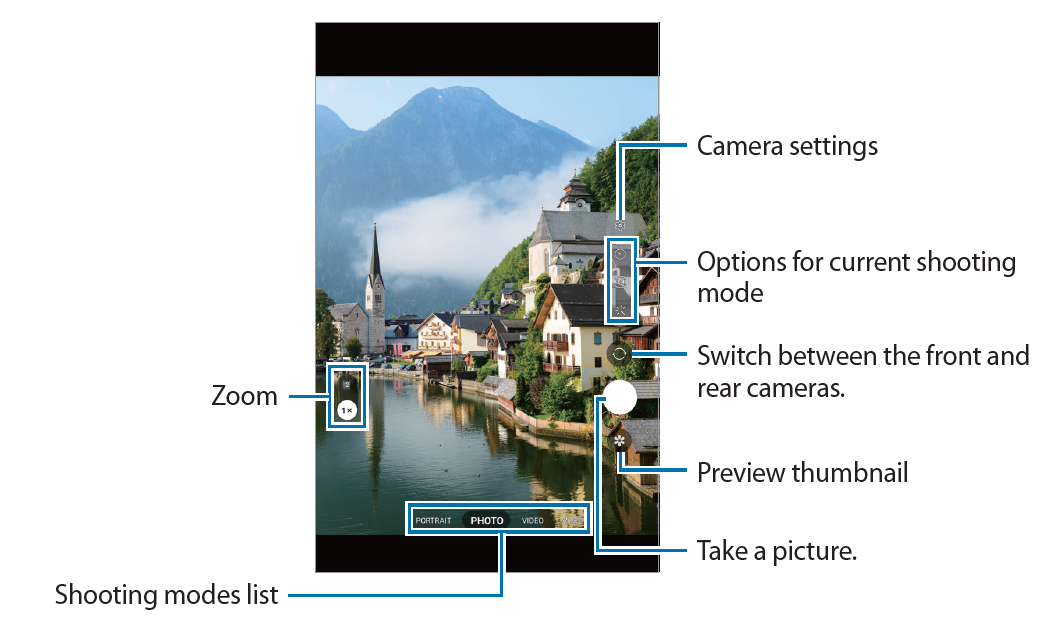
• The preview screen may vary depending on the shooting mode and which camera is being used.
• The focus may not be clear if the subject is close. Take pictures or videos from a good distance.
• If pictures you take appear blurry, clean the camera lens and try again.
• Make sure that the lens is not damaged or contaminated. Otherwise, the device may not work properly in some modes that require high resolutions.
• Your device’s camera features a wide-angle lens. Minor distortion may occur in wideangle pictures or videos and does not indicate device performance problems.
• The maximum capacity for recording a video may vary depending on the resolution.
• The camera may fog up or form condensation if the device is exposed to sudden changes in air temperature, due to the difference in temperature outside and inside the camera cover. Try to avoid such conditions when planning to use the camera. If fogging does occur, allow the camera to dry naturally at room temperature before taking pictures or recording videos, otherwise results may look blurry.
Using zoom features
Select 1x/2x or drag it up or down to zoom in or out. Alternatively, spread two fingers apart on the screen to zoom in, and pinch to zoom out.
- 1x: Take basic pictures or record normal videos.
- 2x: Take pictures or record videos by enlarging the subject.
![]() Zoom features are available only when using the rear camera.
Zoom features are available only when using the rear camera.
Locking the focus (AF) and exposure (AE)
You can lock the focus or exposure on a selected area to prevent the camera from automatically adjusting based on changes to the subjects or light sources.
Tap and hold the area to focus, the AF/AE frame will appear on the area and the focus and exposure setting will be locked. The setting remains locked even after you take a picture.
![]() This feature may not be available depending on the shooting mode.
This feature may not be available depending on the shooting mode.
Using the camera button
- Tap and hold the camera button to record a video.
- To take burst shots, swipe the camera button to the edge of the screen and hold it.
- If you add another camera button, you can move it anywhere on the screen and take pictures more conveniently. On the preview screen, tap
 → Shooting methods and tap the Floating Shutter button switch to activate it.
→ Shooting methods and tap the Floating Shutter button switch to activate it.
Options for current shooting mode
On the preview screen, use the following options.
- :
 : Activate or deactivate the flash.
: Activate or deactivate the flash. - :
 : Select the length of the delay before the camera automatically takes a picture.
: Select the length of the delay before the camera automatically takes a picture. - :
 : Select an aspect ratio for pictures.
: Select an aspect ratio for pictures. - :
 : Select a frame rate.
: Select a frame rate. - :
 : Select an aspect ratio for videos.
: Select an aspect ratio for videos.  : Select a resolution for videos.
: Select a resolution for videos. : Apply a filter effect or beauty effects.
: Apply a filter effect or beauty effects. : Select a metering method. This determines how light values are calculated.
: Select a metering method. This determines how light values are calculated. Centre-weighted metering uses the light in the centre portion of the shot to calculate the exposure of the shot.
Centre-weighted metering uses the light in the centre portion of the shot to calculate the exposure of the shot. Matrix metering averages the entire scene.
Matrix metering averages the entire scene. Spot metering uses the light in a concentrated centre area of the shot to calculate the exposure of the shot.
Spot metering uses the light in a concentrated centre area of the shot to calculate the exposure of the shot. : In FOOD mode, focus on a subject inside the circular frame and blur the image outside the frame.
: In FOOD mode, focus on a subject inside the circular frame and blur the image outside the frame. : In FOOD mode, adjust the colour tone.
: In FOOD mode, adjust the colour tone.
![]() The available options may vary depending on the model or shooting mode.
The available options may vary depending on the model or shooting mode.
Photo mode
The camera adjusts the shooting options automatically depending on the surroundings to capture pictures easily.
On the shooting modes list, tap PHOTO and tap to take a picture.
Taking selfies
You can take self-portraits with the front camera.
- On the preview screen, swipe upwards or downwards, or tap
 to switch to the front camera for self-portraits.
to switch to the front camera for self-portraits. - Face the front camera lens.
To take self-portraits with a wide-angle shot of the landscape or people, tap .
. - Tap
 to take a picture.
to take a picture.
Applying filter and beauty effects
You can select a filter effect and modify facial features, such as your skin tone or face shape, before taking a picture.
- On the preview screen, tap
 .
. - Select effects and take a picture.
Video mode
The camera adjusts the shooting options automatically depending on the surroundings to record videos easily.
- On the shooting modes list, tap VIDEO and tap
 to record a video.
to record a video.
To capture an image from the video while recording, tap .
. - Tap
 to stop recording the video.
to stop recording the video.
Portrait mode
Take pictures that focus on the face by blurring the background.
- On the shooting modes list, tap PORTRAIT.
- Drag the background blur adjustment bar to adjust the blur level.
- When Ready appears on the preview screen, tap
 to take a picture.
to take a picture.
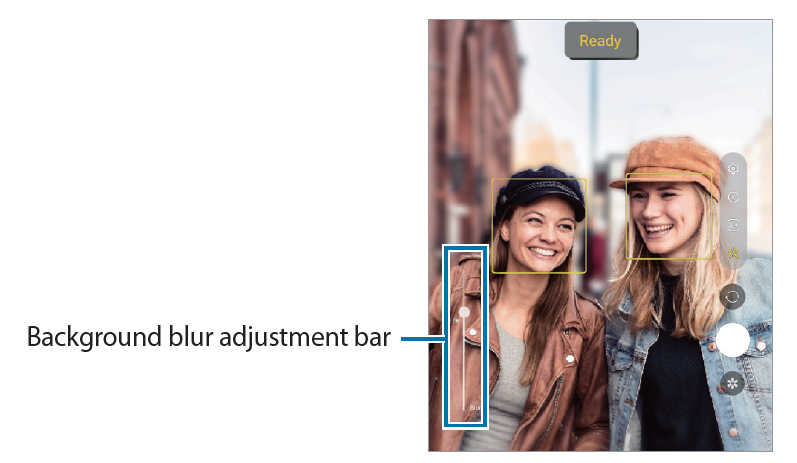
![]()
- Use this feature in a place that has sufficient light.
- The background blur may not be applied properly in the following conditions:
– The device or the subject is moving.
– The subject has a similar colour to the background.
Pro mode
Capture pictures while manually adjusting various shooting options, such as exposure value and ISO value.
On the shooting modes list, tap MORE → PRO. Select options and customise the settings, and then tap ![]() to take a picture.
to take a picture.
Available options
- WB: Select an appropriate white balance, so images have a true-to-life colour range. You can set the colour temperature.
- EV: Change the exposure value. This determines how much light the camera’s sensor receives. For low-light situations, use a higher exposure.
- ISO: Select an ISO value. This controls camera light sensitivity. Low values are for stationary or brightly lit objects. Higher values are for fast-moving or poorly lit objects. However, higher ISO settings can result in noise in pictures.
Panorama mode
Using panorama mode, take a series of pictures and then stitch them together to create a wide scene.
- On the shooting modes list, tap MORE → PANORAMA.
- Tap
 and move the device slowly in one direction.
and move the device slowly in one direction.
Keep the image within the frame on the camera’s viewfinder. If the preview image is out of the guide frame or you do not move the device, the device will automatically stop taking pictures. - Tap
 to stop taking pictures.
to stop taking pictures.
![]() Avoid taking pictures of indistinct backgrounds, such as an empty sky or a plain wall.
Avoid taking pictures of indistinct backgrounds, such as an empty sky or a plain wall.
Food mode
Take pictures of food with more vibrant colours.
- On the shooting modes list, tap MORE → FOOD.
- Tap the screen and drag the circular frame over the area to highlight.
The area outside the circular frame will be blurred.
To resize the circular frame, drag a corner of the frame. - Tap
 and drag the adjustment bar to adjust the colour tone.
and drag the adjustment bar to adjust the colour tone. - Tap
 to take a picture.
to take a picture.
Hyperlapse mode
Record scenes, such as passing people or cars, and view them as fast-motion videos.
- On the shooting modes list, tap MORE → HYPERLAPSE.
- Tap
 and select a frame rate option.
and select a frame rate option. - Tap
 to start recording.
to start recording. - Tap
 to finish recording.
to finish recording.
Deco Pic mode
Capture pictures or videos with various stickers.
On the shooting modes list, tap MORE → DECO PIC.
Customizing camera settings
On the preview screen, tap![]() . Some options may not be available depending on the shooting mode.
. Some options may not be available depending on the shooting mode.
Intelligent features
- Scan QR codes: Set the device to scan QR codes from the preview screen.
Pictures
- Swipe Shutter button to: Select an action to perform when you swipe the camera button to the edge of the screen and hold it.
- Watermark: Add a watermark in the bottom left corner when taking pictures.
Selfies
- Save selfies as previewed: Set the device to save pictures as they appear on the preview screen when taken with the front camera without flipping them.
- Selfie colour tone: Set a tone to apply when you take selfies.
General
- Grid lines: Display viewfinder guides to help composition when selecting subjects.
- Location tags: Attach a GPS location tag to the picture.
 • GPS signal strength may decrease in locations where the signal is obstructed, such as between buildings or in low-lying areas, or in poor weather conditions.
• GPS signal strength may decrease in locations where the signal is obstructed, such as between buildings or in low-lying areas, or in poor weather conditions.
• Your location may appear on your pictures when you upload them to the Internet. To avoid this, deactivate the location tag setting. - Shooting methods: Select additional shooting methods for taking a picture or recording a video.
- Settings to keep: Keep the last settings you used, such as the shooting mode, when you launch the camera.
- Storage location: Select the memory location for storage. This feature will appear when you insert a memory card.
Privacy
- Privacy Notice: View the privacy notice.
- Permissions: View the permissions required to use the Camera app.
- Reset settings: Reset the camera settings.
- Contact us: Ask questions or view frequently asked questions.
- About Camera: View the Camera app version and legal information.
![]() Some features may not be available depending on the model.
Some features may not be available depending on the model.
Gallery
Introduction
View images and videos stored in your device. You can also manage images and videos by album or create stories.
Using Gallery
Launch the Gallery app.
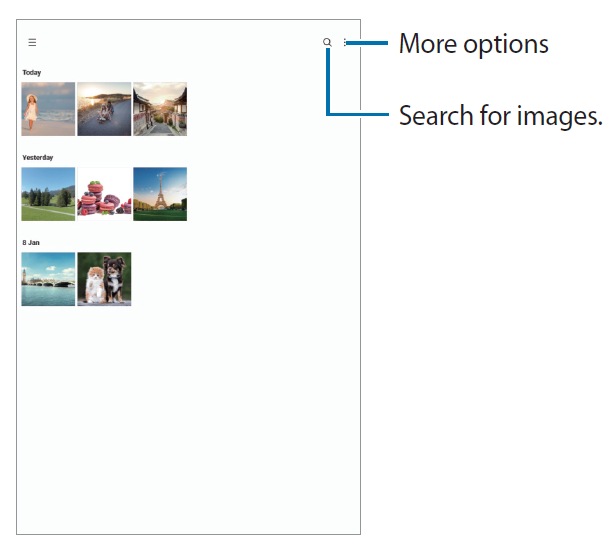
Viewing images
Launch the Gallery app and select an image. To view other files, swipe to the left or right on the screen.

Cropping enlarged images
- Launch the Gallery app and select an image.
- Spread two fingers apart on the area you want to save and tap
 .
.
The cropped area will be saved as a file.

Viewing videos
Launch the Gallery app and select a video to play. To view other files, swipe to the left or right on the screen.

Drag your finger up or down on the left side of the playback screen to adjust the brightness, or drag your finger up or down on the right side of the playback screen to adjust the volume.
To rewind or fast-forward, swipe to the left or right on the playback screen.
Albums
Create albums and sort your images and videos.
- Launch the Gallery app and tap
 → Albums →
→ Albums →  → Album to create an album.
→ Album to create an album. - Select the images or videos you want to copy or move them to an album.
Stories
When you capture or save images and videos, the device will read their date and location tags, sort the images and videos, and then create stories.
Launch the Gallery app, tap → Stories, and then select a story.
Syncing images and videos
Launch the Gallery app, tap ![]() →
→ ![]() → Sync with OneDrive, and then follow the on-screen instructions to complete the sync. The Gallery app and the cloud will be synced.
→ Sync with OneDrive, and then follow the on-screen instructions to complete the sync. The Gallery app and the cloud will be synced.
When your Gallery app is synced with the cloud, pictures and videos you take will also be saved in the cloud. You can view images and videos saved in the cloud in your Gallery app and from other devices.
![]() When you connect your Samsung account and Microsoft account, you can set the cloud storage as Microsoft OneDrive.
When you connect your Samsung account and Microsoft account, you can set the cloud storage as Microsoft OneDrive.
Deleting images or videos
Launch the Gallery app, tap and hold an image, a video, or a story to delete, and then tap Delete.
Using the recycle bin feature
You can keep the deleted images and videos in the recycle bin. The files will be deleted after a certain period.
Launch the Gallery app, tap ![]() →
→![]() , and then tap the Recycle bin switch to activate it.
, and then tap the Recycle bin switch to activate it.
To view files in the recycle bin, launch the Gallery app and tap ![]() → Recycle bin.
→ Recycle bin.
Voice Recorder
Record or play voice recordings.
- Launch the Voice Recorder app.
- Tap
 to start recording. Speak into the microphone.
to start recording. Speak into the microphone.
• Tap to pause recording.
to pause recording.
• While making a voice recording, tap BOOKMARK to insert a bookmark. - Tap
 to finish recording.
to finish recording. - Enter a file name and tap Save.
Sharing content
Share content by using various sharing options. The following actions are an example of sharing images.
- Launch the Gallery app and select an image.
- Tap
 and select a sharing method you want.
and select a sharing method you want.
![]() You may incur additional charges when sharing files via the mobile network.
You may incur additional charges when sharing files via the mobile network.
Quick Share
Sharing content with nearby devices
Share content with nearby devices via Wi-Fi Direct or Bluetooth, or with SmartThings supported devices.
- Launch the Gallery app and select an image.
- On the other device, open the notification panel, swipe downwards, and then tap
 (Quick Share) to activate it. If you cannot find
(Quick Share) to activate it. If you cannot find  (Quick Share) on the quick panel, tap
(Quick Share) on the quick panel, tap  and drag the button over to add it.
and drag the button over to add it. - Tap
 → Quick Share and select a device to transfer the image to.
→ Quick Share and select a device to transfer the image to. - Accept the file transfer request on the other device.
![]()
This feature does not support sharing videos with TVs or SmartThings-supported devices. To watch videos on TV, use the Smart View feature.
Setting who can find your device
Set who is allowed to find and send content to your device.
- Open the notification panel, swipe downwards, and then tap
 (Quick Share).
(Quick Share). - Select an option.
• No one: Do not allow others to find your device.
• Contacts only: Only allow Samsung users in your contacts to share with your device.
• Anyone nearby: Allow any nearby devices to share with your device.
Sharing via Web link
Upload large files to the Samsung storage server and share them with others via Web link.
- Launch the Gallery app and select an image.
- Tap
 → Quick Share and select an option you want under Share link to any person or device.
→ Quick Share and select an option you want under Share link to any person or device.
• Copy link: Share the link copied to the clipboard.
• Share link using app: Share the link by selecting an app.
• Share using QR code: Share the link with the created QR code.
Screen capture
Capture a screenshot while using the device and write on, draw on, crop, or share the captured screen. You can capture the current screen and scrollable area.
How to capture a screenshot
Use the following methods to capture a screenshot. You can view the captured screenshots in Gallery.
Method1) Key capture: Press the Side key and the Volume Down key simultaneously.
Method2) Swipe capture: With the edge of your hand, swipe your hand to the left or right across the screen.
![]()
- It is not possible to capture a screenshot while using some apps and features.
- If capturing a screenshot by swiping is not activated, launch the Settings app, tap Advanced features → Motions and gestures, and then tap the Palm swipe to capture switch to activate it.
After capturing a screenshot, use the following options on the toolbar at the bottom of the screen:

 : Capture the current content and the hidden content on an elongated page, such as a webpage. When you tap
: Capture the current content and the hidden content on an elongated page, such as a webpage. When you tap , the screen will automatically scroll down and more content will be captured.
, the screen will automatically scroll down and more content will be captured. : Write or draw on the screenshot or crop a portion from the screenshot. You can view the cropped area in Gallery.
: Write or draw on the screenshot or crop a portion from the screenshot. You can view the cropped area in Gallery. : Share the screenshot with others.
: Share the screenshot with others.
![]()
If the options are not visible on the captured screen, launch the Settings app, tap Advanced features → Screenshots, and then tap the Show toolbar after capturing switch to activate it.
Transferring data from your previous device (Smart Switch)
You can use Smart Switch to transfer data from your previous device to your new device. Launch the Settings app and tap Accounts and backup → Bring data from old device.
![]()
- This feature may not be supported on some devices or computers.
- Limitations apply. Visit www.samsung.com/smartswitch for details. Samsung takes copyright seriously. Only transfer content that you own or have the right to transfer.
Transferring data wirelessly
Transfer data from your previous device to your device wirelessly via Wi-Fi Direct.
- On the previous device, launch Smart Switch.
If you do not have the app, download it from Galaxy Store or Play Store. - On your device, launch the Settings app and tap Accounts and backup → Bring data from old device.
- Place the devices near each other.
- On the previous device, tap Send data → Wireless.
- On your device, tap Receive data, select your previous device’s operating system, and then tap Wireless.
- On the previous device, tap Allow.
- On your device, select an option you want, tap Next, and then follow the on-screen instructions to transfer data.
Backing up and restoring data using external storage
Transfer data using external storage, such as a microSD card.
- Back up data from your previous device to external storage.
- Insert or connect the external storage device to your device.
- On your device, launch the Settings app and tap Accounts and backup → External storage transfer.
- Select the backup date under Restore from SD card.
- Select an option you want, tap Next, and then follow the on-screen instructions to transfer data.
Transferring backup data from a computer
Transfer data between your device and a computer. You must download the Smart Switch computer version app from www.samsung.com/smartswitch. Back up data from your previous device to a computer and import the data to your device.
- On the computer, visit www.samsung.com/smartswitch to download Smart Switch.
- On the computer, launch Smart Switch.
 If your previous device is not a Samsung device, back up data to a computer using a program provided by the device’s manufacturer. Then, skip to the fifth step.
If your previous device is not a Samsung device, back up data to a computer using a program provided by the device’s manufacturer. Then, skip to the fifth step. - Connect your previous device to the computer using the device’s USB cable.
- On the computer, follow the on-screen instructions to back up data from the device. Then, disconnect your previous device from the computer.
- Connect your device to the computer using the USB cable.
- On the computer, follow the on-screen instructions to transfer data to your device.
Settings
Introduction
Customise device settings.
Launch the Settings app.
To search for settings by entering keywords, tap![]() .
.
This chapter is a common manual for settings and features provided by Samsung devices.
Depending on the model, some content may differ, or descriptions of options or features not available on your device may be included.

Samsung account
Sign in to your Samsung account and manage it.
On the Settings screen, tap Samsung account.
Connections
Options
Change settings for various connections, such as the Wi-Fi feature and Bluetooth.
On the Settings screen, tap Connections.
- Wi-Fi: Activate the Wi-Fi feature to connect to a Wi-Fi network and access the Internet or other network devices. Refer to Wi-Fi for more information.
- Bluetooth: Use Bluetooth to exchange data or media files with other Bluetooth-enabled devices. Refer to Bluetooth for more information.
- Flight mode: Set the device to disable all wireless functions on your device. You can use only non-network services.
 Follow the regulations provided by the airline and the instructions of aircraft personnel. In cases where it is allowed to use the device, always use it in flight mode.
Follow the regulations provided by the airline and the instructions of aircraft personnel. In cases where it is allowed to use the device, always use it in flight mode. - Mobile networks: Configure your mobile network settings.
- Data usage: Keep track of your data usage amount and customise the settings for the limitation. Set the device to automatically disable the mobile data connection when the amount of mobile data you have used reaches your specified limit.
You can activate the data saver feature to prevent some apps running in the background from sending or receiving data. Refer to Data saver (Mobile network enabled models) for more information.
You can also select apps to always use the mobile data even when your device is connected to a Wi-Fi network. Refer to Mobile data only apps (Mobile network enabled models) for more information. - Mobile Hotspot and Tethering: Use the device as a mobile hotspot to share the device’s mobile data connection with other devices. For more information about the mobile hotspot, refer to Mobile Hotspot (Mobile network enabled models).
 You may incur additional charges when using this feature.
You may incur additional charges when using this feature. - More connection settings: Customise settings to control other features. Refer to More connection settings for more information.
![]() Some features may not be available depending on the model.
Some features may not be available depending on the model.
Wi-Fi
Activate the Wi-Fi feature to connect to a Wi-Fi network and access the Internet or other network devices.
Connecting to a Wi-Fi network
1 On the Settings screen, tap Connections → Wi-Fi and tap the switch to activate it.
2 Select a network from the Wi-Fi networks list.
Networks with a lock icon require a password.
• Once the device connects to a Wi-Fi network, the device will reconnect to that network each time it is available without requiring a password. To prevent the device from connecting to the network automatically, tap next to the network and tap the Auto reconnect switch to deactivate it.
• If you cannot connect to a Wi-Fi network properly, restart your device’s Wi-Fi feature or the wireless router.
Viewing the Wi-Fi network quality information
View the Wi-Fi network quality information, such as the speed and stability.
On the Settings screen, tap Connections → Wi-Fi and tap the switch to activate it. The network quality information will appear under the Wi-Fi networks. If it does not appear, tap → Intelligent Wi-Fi and tap the Show network quality info switch to activate it.
![]() The quality information may not appear depending on the Wi-Fi network.
The quality information may not appear depending on the Wi-Fi network.
Sharing Wi-Fi network passwords
If you make a request to a person who is connected to a secured Wi-Fi network to share its password, you can connect to the network without entering the password. This feature is available between the devices which have contacts each other and the screen of the other device must be turned on.
- On the Settings screen, tap Connections → Wi-Fi and tap the switch to activate it.
- Select a network from the Wi-Fi networks list.
- Tap Request password.
- Accept the share request on the other device.
The Wi-Fi password is entered on your device and it is connected to the network.
Wi-Fi Direct
Wi-Fi Direct connects devices directly via a Wi-Fi network without requiring an access point.
- On the Settings screen, tap Connections → Wi-Fi and tap the switch to activate it.
- Tap
 → Wi-Fi Direct.
→ Wi-Fi Direct.
The detected devices are listed.
If the device you want to connect to is not in the list, request that the device turns on its Wi-Fi Direct feature. - Select a device to connect to.
The devices will be connected when the other device accepts the Wi-Fi Direct connection request.
To end the device connection, select the device to disconnect from the list.
Bluetooth
Use Bluetooth to exchange data or media files with other Bluetooth-enabled devices.
![]() Precautions for using Bluetooth
Precautions for using Bluetooth
- Samsung is not responsible for the loss, interception, or misuse of data sent or received via Bluetooth.
- Always ensure that you share and receive data with devices that are trusted and properly secured. If there are obstacles between the devices, the operating distance may be reduced.
- Some devices, especially those that are not tested or approved by the Bluetooth SIG, may be incompatible with your device.
- Do not use the Bluetooth feature for illegal purposes (for example, pirating copies of files or illegally tapping communications for commercial purposes). Samsung is not responsible for the repercussion of illegal use of the Bluetooth feature.
Pairing with other Bluetooth devices
- On the Settings screen, tap Connections → Bluetooth and tap the switch to activate it.
The detected devices will be listed. - Select a device to pair with.
If the device you want to pair with is not on the list, set the device to enter Bluetooth pairing mode. Refer to the other device’s user manuals.
 Your device is visible to other devices while the Bluetooth settings screen is open.
Your device is visible to other devices while the Bluetooth settings screen is open. - Accept the Bluetooth connection request on your device to confirm.
The devices will be connected when the other device accepts the Bluetooth connection request.
To unpair the devices, tap next to the device name to unpair and tap Unpair.
next to the device name to unpair and tap Unpair.
Sending and receiving data
Many apps support data transfer via Bluetooth. You can share data, such as contacts or media files, with other Bluetooth devices. The following actions are an example of sending an image to another device.
- Launch the Gallery app and select an image.
- Tap
 → Bluetooth and select a device to transfer the image to.
→ Bluetooth and select a device to transfer the image to.
If the device you want to pair with is not in the list, request that the device turns on its visibility option. - Accept the Bluetooth connection request on the other device.
Data saver (Mobile network enabled models)
Reduce your data usage by preventing some apps running in the background from sending or receiving data.
On the Settings screen, tap Connections → Data usage → Data saver and tap the switch to activate it.
When the data saver feature is activated, the ![]() icon will appear on the status bar.
icon will appear on the status bar.

![]() To select apps to use data without restriction, tap Allowed to use data while Data saver is on and select apps.
To select apps to use data without restriction, tap Allowed to use data while Data saver is on and select apps.
Mobile data only apps (Mobile network enabled models)
Select apps to always use the mobile data even when your device is connected to a Wi-Fi network.
For example, you can set the device to use only mobile data for apps that you want to keep secure or streaming apps that can be disconnected. Even if you do not deactivate the Wi-Fi feature, the apps will launch using the mobile data.
On the Settings screen, tap Connections → Data usage → Mobile data only apps and tap the switches next to the apps you want.
![]() You may incur additional charges when using this feature.
You may incur additional charges when using this feature.
Mobile Hotspot (Mobile network enabled models)
Use your device as a mobile hotspot to share your device’s mobile data connection with other devices.
- On the Settings screen, tap Connections → Mobile Hotspot and Tethering → Mobile Hotspot.
- Tap the switch to activate it.
The icon appears on the status bar.
icon appears on the status bar.
You can change the level of security and the password by tapping Configure. - On the other device’s screen, search for and select your device from the Wi-Fi networks list. Alternatively, tap QR code on the mobile hotspot screen and scan the QR code with the other device.
![]()
- If the mobile hotspot is not found, on your device, tap Configure and set Band to 2.4 GHz, tap Advanced, and then tap the Hidden network switch to deactivate it.
- If you activate the Auto Hotspot feature, you can share your device’s mobile data connection with other devices signed in to your Samsung account.
More connection settings
Customise settings to control other connection features.
On the Settings screen, tap Connections → More connection settings.
- Nearby device scanning: Set the device to scan for nearby devices to connect to.
- Printing: Configure settings for printer plug-ins installed on the device. You can search for available printers or add one manually to print files. Refer to Printing for more information.
- VPN: Set up virtual private networks (VPNs) on your device to connect to a school or company’s private network.
- Private DNS: Set the device to use the security enhanced private DNS.
- Ethernet: When you connect an Ethernet adaptor, you can use a wired network and configure network settings.
Printing
Configure settings for printer plug-ins installed on the device. You can connect the device to a printer via Wi-Fi or Wi-Fi Direct, and print images or documents.
![]() Some printers may not be compatible with the device.
Some printers may not be compatible with the device.
Adding printer plug-ins
Add printer plug-ins for printers you want to connect the device to.
- On the Settings screen, tap Connections → More connection settings → Printing → Download plugin.
- Select a printer plug-in and install it.
- Select the installed printer plug-in.
The device will automatically search for printers that are connected to the same Wi-Fi network as your device. - Select a printer to add.
![]() To add printers manually, tap
To add printers manually, tap ![]() → Add printer.
→ Add printer.
Printing content
While viewing content, such as images or documents, access the options list, tap Print → ![]() → All printers…, and then select a printer.
→ All printers…, and then select a printer.
![]() Printing methods may vary depending on the content type.
Printing methods may vary depending on the content type.
Connected devices
Change settings for device connections.
On the Settings screen, tap Connected devices.
- Quick Share: Change the Quick Share settings. Refer to Quick Share for more information.
- Auto switch Buds: Set the Galaxy Buds to switch from another device to your tablet when you make or answer a call, play media, and more. You can use this feature only when you signed in to the same Samsung account on the other device and you are wearing your Galaxy Buds.
- Call & text on other devices: Connect your tablet and smartphone to use calling and messaging features on the tablet with your smartphone number. You must register and sign in to the same Samsung account on the tablet and smartphone. Some calling and messaging features may not be available.
- Continue apps on other devices: Use your device’s apps on other devices signed in to your Samsung account.
- SmartThings: Control and manage smart appliances and Internet of Things (IoT) products. Refer to SmartThings for more information.
- Android Auto: Connect your device to a vehicle and control some of your device’s features on the vehicle’s display.
Modes and Routines
Introduction
Select a mode based on your current activity or location, or add your repeated usage patterns as routines and use your device more conveniently.
On the Settings screen, tap Modes and Routines.
Using modes
Adding modes
- On the Settings screen, tap Modes and Routines → Modes.
- Select a mode you want or tap Add mode → Custom to add your own modes.
Running modes
Modes will run automatically when their conditions are detected. You can also run them manually by tapping the button whenever you want.
To run modes manually, select the mode you want and tap Turn on.
To turn off a running mode, tap the mode and tap Turn off.
Using routines
Adding routines
- On the Settings screen, tap Modes and Routines → Routines.
- Tap
 and select a routine you want or tap
and select a routine you want or tap  to add your own routines.
to add your own routines.
If you want to set the routine’s running condition to manual, tap Start manually. This option will appear only when there are no running conditions set. When a pop-up window appears, tap Add. You can add the routine to the Home screen as a widget and access it quickly.
Running routines
Auto routines will run automatically when their conditions are detected. For routines which you set the running condition as Start manually, you can run them manually by tapping the button whenever you want.
To run routines manually, tap ![]() next to the routine you want to run. Alternatively, tap the routine’s widget on the Home screen.
next to the routine you want to run. Alternatively, tap the routine’s widget on the Home screen.
To stop running routines, tap the routine under Running and tap Stop.
Sounds and vibration / Sound
Options
Change settings for various sounds on the device.
On the Settings screen, tap Sounds and vibration / Sound.
- Sound / Vibrate / Mute: Set the device to use sound mode, vibration mode, or silent mode.
- Vibrate while ringing: Set the device to vibrate and play a ringtone for incoming calls.
- Temporary mute: Set the device to use silent mode for a certain period.
- Ringtone: Change the call ringtone.
- Notification sound: Change the notification sound.
- System sound: Change the sound to use for certain actions, such as charging the device.
- Volume: Adjust the device’s volume level.
- Call vibration: Change the call vibration settings.
- Notification vibration: Change the notification vibration settings.
- System vibration: Set the device to vibrate for actions, such as controlling the touchscreen.
- Vibration intensity: Adjust the force of the vibration notification.
- Sound quality and effects: Set the device’s sound quality and effects. Refer to Sound quality and effects for more information.
- Separate app sound: Set the device to play media sound from a specific app separately on the other audio device. Refer to Separate app sound for more information.
![]() Some features may not be available depending on the model.
Some features may not be available depending on the model.
Sound quality and effects
Set the device’s sound quality and effects.
On the Settings screen, tap Sounds and vibration / Sound → Sound quality and effects.
- Dolby Atmos: Select a surround sound mode optimised for various types of audio, such as movies, music, and voice. With Dolby Atmos, you can experience moving audio sounds that flow all around you.
- Dolby Atmos for gaming: Experience the Dolby Atmos sound optimised for games while playing games.
![]() Depending on the model, you must connect an earphone to use some features.
Depending on the model, you must connect an earphone to use some features.
Separate app sound
Set the device to play media sound from a specific app on the connected Bluetooth speaker or headset.
For example, you can listen to the Navigation app through your device’s speaker while listening to playback from the Music app through the vehicle’s Bluetooth speaker.
- On the Settings screen, tap Sounds and vibration / Sound → Separate app sound and tap the switch to activate it.
- Select an app to play media sounds separately and tap the Back button.
- Select a device for playing the selected app’s media sound.
Notifications
Change the notification settings.
On the Settings screen, tap Notifications.
- App notifications: Select the apps you want to receive notifications from.
- Lock screen notifications: Set how to show notifications on the locked screen.
- Notification pop-up style: Select a notification pop-up style and change the settings.
- Do not disturb: Set the device to mute all sounds except for allowed exceptions.
- Advanced settings: Configure advanced settings for notifications.
Display
Change the display and the Home screen settings.
On the Settings screen, tap Display.
- Light / Dark: Activate or deactivate dark mode.
- Dark mode settings: Reduce eye strain by applying the dark theme when using the device at night or in a dark place. You can set a schedule for applying dark mode.
 The dark theme may not be applied in some apps.
The dark theme may not be applied in some apps. - Brightness: Adjust the brightness of the display.
- Adaptive brightness: Set the device to keep track of your brightness adjustments and apply them automatically in similar lighting conditions.
- Eye comfort shield: Reduce eye strain by limiting the amount of blue light emitted by the screen. You can set a schedule for applying this feature.
- Font size and style: Change the font size and style.
- Screen zoom: Make the items on the screen larger or smaller.
- Screen timeout: Set the length of time the device waits before turning off the display’s backlight.
- Edge panels: Change the settings for the Edge panel.
- Taskbar: Change the settings for the taskbar. Refer to Taskbar for more information.
- Navigation bar: Change the navigation bar settings. Refer to Navigation bar (soft buttons) for more information.
- Screen saver: Set the device to launch a screensaver when the device is charging.
Some features may not be available depending on the model.
Wallpaper and style
Change the wallpaper settings for the Home screen and the locked screen.
On the Settings screen, tap Wallpaper and style.
Home screen
Configure settings for the Home screen, such as the screen layout.
On the Settings screen, tap Home screen.
Lock screen
Options
Change the settings for the locked screen.
On the Settings screen, tap Lock screen.
- Screen lock type: Change the screen lock method.
- Smart Lock: Set the device to unlock itself when trusted locations or devices are detected. Refer to Smart Lock for more information.
- Secure lock settings: Change screen lock settings for the selected lock method.
- Lock screen: Change the settings of the items displayed on the locked screen and the wallpaper for the locked screen.
- Widgets: Change the settings of the items displayed when you tap the clock on the locked screen.
- Touch and hold to edit: Set the device to display the editing options when you tap and hold the locked screen.
- Roaming clock: Change the clock to show both the local and home time zones on the locked screen when roaming.
- About Lock screen: View the Lock screen version and legal information.
![]()
- Some features may not be available depending on the service provider or model.
- The available options may vary depending on the screen lock method selected.
Smart Lock
You can set the device to unlock itself and remain unlocked when trusted locations or devices are detected.
For example, if you have set your home as a trusted location, when you get home your device will detect the location and automatically unlock itself.
On the Settings screen, tap Lock screen → Smart Lock and follow the on-screen instructions to complete the setup.
![]()
- This feature will be available to use after you set a screen lock method.
- If you do not use your device for four hours or when you turn on the device, you must unlock the screen using the pattern, PIN, or password you set.
Security and privacy
Options
Check the device’s security and privacy status and change the settings.
On the Settings screen, tap Security and privacy.
- Lock screen: Change the settings for the locked screen.
- Accounts: Change the settings for your accounts.
- Find My Mobile: Activate or deactivate the Find My Mobile feature. Access the Find My Mobile website (findmymobile.samsung.com) to track and control your lost or stolen device.
- App security: Scan apps and keep your device safe from malicious software.
- Updates: View the version of your device’s software and check for updates.
- Privacy: Change the settings for privacy.
- Biometrics: Change the settings for biometric data. Refer to Face recognition for more information.
- Private Share: Share files with others securely using blockchain technology.
- Install unknown apps: Set the device to allow the installation of apps from unknown sources.
- Other security settings: Configure additional security settings.
![]() Some features may not be available depending on the service provider or model.
Some features may not be available depending on the service provider or model.
Face recognition
You can set the device to unlock the screen by recognizing your face.
![]()
- If you use your face as a screen lock method, your face cannot be used to unlock the screen for the first time after turning on the device. To use the device, you must unlock the screen using the pattern, PIN, or password you set when registering the face. Be careful not to forget your pattern, PIN, or password.
- If you change the screen lock method to Swipe or None, which are not secure, all of your biometric data will be deleted.
![]() Precautions for using face recognition
Precautions for using face recognition
Before using the face recognition to unlock your device, keep the following precautions in mind.
- Your device could be unlocked by someone or something that looks like your image.
- Face recognition is less secure than Pattern, PIN, or Password.
For better face recognition
Consider the following when using face recognition:
- Consider the conditions when registering, such as wearing glasses, hats, masks, beards, or heavy makeup
- Ensure that you are in a well-lit area and that the camera lens is clean when registering
- Ensure your image is not blurry for better match results
Registering your face
For better face registration, register your face indoors and out of direct sunlight.
- On the Settings screen, tap Security and privacy → Biometrics → Face recognition.
- Read the on-screen instructions and tap Continue.
- Set a screen lock method.
- Position your face inside the frame on the screen.
The camera will scan your face.
![]() If unlocking the screen with your face is not working properly, tap Remove face data to remove your registered face and register your face again.
If unlocking the screen with your face is not working properly, tap Remove face data to remove your registered face and register your face again.
Unlocking the screen with your face
You can unlock the screen with your face instead of using a pattern, PIN, or password.
- On the Settings screen, tap Security and privacy → Biometrics → Face recognition.
- Unlock the screen using the preset screen lock method.
- Tap the Face unlock switch to activate it.
- On the locked screen, look at the screen.
When your face is recognised, you can unlock the screen without using any additional screen lock method. If your face is not recognised, use the preset screen lock method.
Deleting the registered face data
You can delete face data that you have registered.
- On the Settings screen, tap Security and privacy → Biometrics → Face recognition.
- Unlock the screen using the preset screen lock method.
- Tap Remove face data → Remove.
Once the registered face is deleted, all the related features will also be deactivated.
Location
Change settings for location information permissions.
On the Settings screen, tap Location.
- App permissions: View the list of apps that have permission to access the device’s location and edit the permission settings.
- Location services: Set the device to use the Wi-Fi or Bluetooth feature to increase the accuracy of your location information, even when the features are deactivated. You can also view the location services your device is using.
- Recent access: View which apps request your current location information.
Safety and emergency
Manage your medical information and emergency contacts. You can also change settings for emergency features, such as wireless emergency alerts.
On the Settings screen, tap Safety and emergency.
- Medical info: Enter your medical information.
- Emergency contacts: Enter your emergency contacts.
- Emergency SOS: Set the device to make an emergency call to the preset number when you press the Side key five times.
- Emergency sharing: Set the device to send information, such as your location or your device’s lower battery notifications, to your emergency contacts for a certain period of time.
- Emergency Location Service: Activate the Emergency Location Service (ELS) feature.
- Wireless emergency alerts: Change the settings for wireless emergency alerts.
![]() Some features may not be available depending on the model.
Some features may not be available depending on the model.
Accounts and backup
Options
Sync, back up, or restore your device’s data using Samsung Cloud. You can also sign in to accounts, such as your Samsung account or Google account, or transfer data to or from other devices via Smart Switch.
On the Settings screen, tap Accounts and backup.
- Manage accounts: Add your Samsung and Google accounts, or other accounts, to sync with.
- Users: Set up additional user accounts for other users to use the device with personalised settings, such as email accounts, wallpaper preferences, and more. Refer to Users for more information.
 This feature may not be available depending on the region or service provider.
This feature may not be available depending on the region or service provider. - Samsung Cloud: Back up your data and settings, and restore the previous device’s data and settings even when you do not have it. Refer to Samsung Cloud for more information.
- Google Drive: Keep your personal information, app data, and settings safe on your device. You can back up your sensitive information. You must sign in to your Google account to back up data.
- Smart Switch: Launch Smart Switch and transfer data from your previous device. Refer to Transferring data from your previous device (Smart Switch) for more information.
![]()
Regularly back up your data to a safe location, such as Samsung Cloud or a computer, so that you can restore it if the data is corrupted or lost due to an unintended factory data reset.
Users
Set up additional user accounts for other users to use the device with personalised settings, such as email accounts, wallpaper preferences, and more.
![]() This feature may not be available depending on the region or service provider.
This feature may not be available depending on the region or service provider.
Following types of user accounts are available:
- Administrator: The administrator account is created only when setting up the device for the first time, and cannot be created more than one. This account has full control of the device including user account management. You can add or delete user accounts only when using this account.
- Guest: This account allows guests to access the device. Information and data used during a guest session is temporarily stored. Each time you use this account, you are asked whether to continue the previous guest session or reset it.
- New user: This account allows users to access their own apps and content, and customise the device settings that affect all accounts.
- New profile: A restricted account can only access the apps and content allowed by the administrator account, and cannot use the services that require logging in. (SM-T220, SM-T227)
Adding users
- On the Settings screen, tap Accounts and backup → Users.
- Tap Add user / Add user or profile and follow the on-screen instructions to set up a user account.
Adding restricted profiles (SM-T220, SM-T227)
- On the Settings screen, tap Accounts and backup → Users.
- Tap Add user or profile → Restricted profile and follow the on-screen instructions to set up a user account.
Switching users
Tap the user account icon at the top of the locked screen and select an account to switch to.
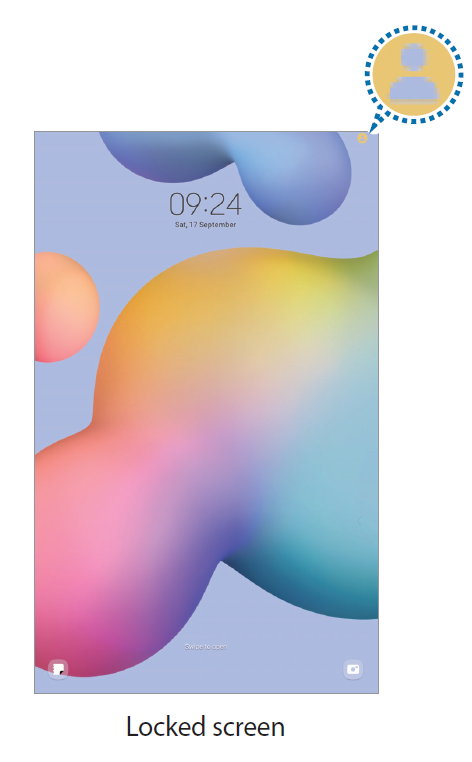
Managing users
When using the administrator account, you can delete accounts or change account settings. On the Settings screen, tap Accounts and backup → Users.
To delete a user account, tap the user account you want to delete and tap Delete user.
To change account settings, tap user account and change the settings.
Samsung Cloud
Back up your device’s data to Samsung Cloud and restore it later.
Backing up data
You can back up your device’s data to Samsung Cloud.
- On the Settings screen, tap Accounts and backup and tap Back up data under Samsung Cloud.
- Tap the switches next to the items you want to back up and tap Back up now.
- Tap Done.
 • Some data will not be backed up. To check which data will be backed up, on the Settings screen, tap Accounts and backup and tap Back up data under Samsung Cloud.
• Some data will not be backed up. To check which data will be backed up, on the Settings screen, tap Accounts and backup and tap Back up data under Samsung Cloud.
• To view the backup data for other devices in your Samsung Cloud, on the Settings screen, tap Accounts and backup → Restore data, and then select a device you want.
Restoring data
You can restore your backup data from Samsung Cloud to your device.
- On the Settings screen, tap Accounts and backup.
- Tap Restore data and select a device you want.
- Tick items you want to restore and tap Restore.
Configure settings for some features provided by Google.
On the Settings screen, tap Google.
Advanced features
Options
Activate advanced features and change the settings that control them.
On the Settings screen, tap Advanced features.
- Labs: Use new features of the device.
- Side key: Select an app or feature to launch using the Side key. Refer to Setting the Side key for more information.
- Motions and gestures: Activate the motion feature and configure settings. Refer to Motions and gestures for more information.
- Screenshots: Change the settings for screenshots.
- Show contacts when sharing content: Set the device to display the people you contacted on the sharing options panel to allow you to share content directly.
- Game Launcher: Activate the Game Launcher. Refer to Game Launcher for more information.
![]() Some features may not be available depending on the service provider or model.
Some features may not be available depending on the service provider or model.
Motions and gestures
Activate the motion feature and configure settings.
On the Settings screen, tap Advanced features → Motions and gestures.
- Double tap to turn on screen: Set the device to turn on the screen by double-tapping anywhere on the screen while the screen is turned off.
- Double tap to turn off screen: Set the device to turn off the screen by double-tapping an empty area on the Home screen or the locked screen.
- Cover screen to mute: Set the device to mute certain sounds by using motions or gestures.
- Palm swipe to capture: Set the device to capture a screenshot when you swipe your hand to the left or right across the screen. You can view the captured images in Gallery. It is not possible to capture a screenshot while using some apps and features.
![]()
• Some features may not be available depending on the model.
• Excessive shaking or an impact to the device may cause an unintended input for some features using sensors.
Digital Wellbeing and parental controls
View the history of your device usage and use features to prevent your device from interfering with your life. You can also set up parental controls for your children and manage their digital use.
On the Settings screen, tap Digital Wellbeing and parental controls.
- Screen time goal: Set goals for how much you use your device a day.
- App timers: Limit the daily usage time for each app by setting a timer. When you reach the limit, the app will be deactivated and you cannot use it.
- Driving monitor: Activate the driving monitor to monitor the amount of the time you use your device while driving.
- Parental controls: Manage your children’s digital use.
Battery and device care
Introduction
The device care feature provides an overview of the status of your device’s battery, storage, memory, and system security. You can also automatically optimise the device with a tap of your finger.
Optimising your device
On the Settings screen, tap Battery and device care → Optimise now.
The quick optimisation feature improves device performance through the following actions.
- Closing apps running in the background.
- Managing abnormal battery usage.
- Scanning for crashed apps and malware.
Battery
Check the remaining battery power and time to use the device. For devices with low battery levels, conserve battery power by activating power saving features.
On the Settings screen, tap Battery and device care → Battery.
- Power saving: Activate power saving mode to extend the battery’s usage time.
- Background usage limits: Limit battery usage for apps that you do not use often.
- More battery settings: Configure advanced settings for the battery.
![]() • The usage time left shows the time remaining before the battery power runs out. Usage time left may vary depending on your device settings and operating conditions.
• The usage time left shows the time remaining before the battery power runs out. Usage time left may vary depending on your device settings and operating conditions.
• You may not receive notifications from some apps that use power saving mode.
Storage
Check the status of the used and available memory.
On the Settings screen, tap Battery and device care → Storage. To delete files or uninstall apps that you do not use anymore, select a category. Then, tap and hold, or select, an item and tap Delete or Uninstall.
![]()
- The actual available capacity of the internal memory is less than the specified capacity because the operating system and default apps occupy part of the memory. The available capacity may change when you update the device.
- You can view the available capacity of the internal memory in the Specification section for your device on the Samsung website.
Memory
On the Settings screen, tap Battery and device care → Memory.
To speed up your device by stopping apps running in the background, tick apps from the apps list, and tap Clean now.
Device protection
Check the device’s security status. This feature scans your device for malware.
On the Settings screen, tap Battery and device care → Device protection → Scan tablet.
Auto optimisation
You can set the device to perform auto optimisation when your device is not in use.
On the Settings screen, tap Battery and device care → Auto optimisation and tap the Restart when needed switch to activate it.
Software update
Update your device’s software via the firmware over-the-air (FOTA) service. You can also schedule software updates.
On the Settings screen, tap Battery and device care → Software update.
Diagnostics
Test your device using Samsung Members.
On the Settings screen, tap Battery and device care → Diagnostics. Select an item to test or tap Test all to test all items.
Apps
Manage the device’s apps and change their settings. You can view the apps’ usage information, change their notification or permission settings, or uninstall or disable unnecessary apps.
On the Settings screen, tap Apps.
General management
Customise your device’s system settings or reset the device.
On the Settings screen, tap General management.
- Language: Select device languages. Refer to Adding device languages for more information.
- App languages: Select the language you want to use for each app.
- Text-to-speech output: Change the settings for text-to-speech features used when TalkBack is activated, such as languages, speed, and more.
- Voice input: Download language packs to use the voice input feature offline.
- Date and time: Access and alter the settings to control how the device displays the time and date.
 If the battery remains fully discharged, the time and date is reset.
If the battery remains fully discharged, the time and date is reset. - Samsung Keyboard settings: Change the settings for the Samsung keyboard.
- Keyboard list and default: Select a keyboard to use by default and change the keyboard settings.
- Physical keyboard: Change the settings for an external keyboard.
- Mouse and trackpad: Change the settings for an external mouse or trackpad.
- Passwords and autofill: Select an autofill service to use.
- Reset: Reset your device’s settings or perform a factory data reset.
- Contact us: Ask questions or view frequently asked questions.
Adding device languages
You can add languages to use on your device.
- On the Settings screen, tap General management → Language → Add language.
To view all the languages that can be added, tap → All languages.
→ All languages. - Select a language to add.
- To set the selected language as the default language, tap Set as default. To keep the current language setting, tap Keep current.
The selected language will be added to your languages list. If you changed the default language, the selected language will be added to the top of the list.
To change the default language from your languages list, select the language you want and tap Apply. If an app does not support the default language, the next supported language in the list will be used.
Accessibility
Configure various settings to improve accessibility to the device.
On the Settings screen, tap Accessibility.
- Recommended for you: Check the accessibility features you are currently using and see other recommended features.
- TalkBack: Activate TalkBack, which provides voice feedback. To view help information to learn how to use this feature, tap Settings → Tutorial and help.
- Spoken assistance: Use the voice assistant features.
- Visibility enhancements: Customise the settings to improve accessibility for visually impaired users.
- Hearing enhancements: Customise the settings to improve accessibility for users with hearing impairment.
- Interaction and dexterity: Customise the settings to improve accessibility for users who have reduced dexterity.
- Advanced settings: Configure settings for Direct access and notification features.
- Installed apps: View accessibility services installed on the device.
- About Accessibility: View the Accessibility information.
- Contact us: Ask questions or view frequently asked questions.
Software update
Update your device’s software via the firmware over-the-air (FOTA) service. You can also schedule software updates.
On the Settings screen, tap Software update.
- Download and install: Check for and install updates manually.
- Auto download over Wi-Fi: Set the device to download updates automatically when connected to a Wi-Fi network.
- Last update: View information about the last software update.
![]() If emergency software updates are released for your device’s security and to block new types of security threats, they will be installed automatically without your agreement.
If emergency software updates are released for your device’s security and to block new types of security threats, they will be installed automatically without your agreement.
Security updates information
Security updates are provided to strengthen the security of your device and protect your personal information. For security updates for your model, visit security.samsungmobile.com.
![]() The website supports only some languages.
The website supports only some languages.
Remote support
If you have any questions or technical problems with your device, you can get help through the remote support service.
On the Settings screen, tap Remote support.
About tablet
Access your device’s information.
On the Settings screen, tap About tablet.
To change your device’s name, tap Edit.
- Status information: View various device information, such as the Wi-Fi MAC address and serial number.
- Legal information: View legal information related to the device, such as safety information and the open source licence.
- Software information: View the device’s software information, such as its operating system version and firmware version.
- Battery information: View the device’s battery status and information.
Usage notices

Precautions for using the device
Please read this manual when using the device to ensure safe and proper use.
- Descriptions are based on the device’s default settings.
- Some content may differ from your device depending on the region, service provider, model specifications, or device’s software.
- The device may require a connection to a Wi-Fi or mobile network when using some apps or features.
- Content (high quality content) that requires high CPU and RAM usage will affect the overall performance of the device. Apps related to the content may not work properly depending on the device’s specifications and the environment that it is used in.
- Samsung is not liable for performance issues caused by apps supplied by providers other than Samsung.
- Samsung is not liable for performance issues or incompatibilities caused by edited registry settings or modified operating system software. Attempting to customise the operating system may cause the device or apps to work improperly.
- Software, sound sources, wallpapers, images, and other media provided with this device are licensed for limited use. Extracting and using these materials for commercial or other purposes is an infringement of copyright laws. Users are entirely responsible for illegal use of media.
- You may incur additional charges for data services, such as messaging, uploading and downloading, auto-syncing, or using location services depending on your data plan. For large data transfers, it is recommended to use the Wi-Fi feature.
- Default apps that come with the device are subject to updates and may no longer be supported without prior notice.
- Modifying the device’s operating system or installing software from unofficial sources may result in device malfunctions and data corruption or loss. These actions are violations of your Samsung licence agreement and will void your warranty.
- Depending on the region or service provider, a screen protector is attached for protection during production and distribution. Damage to the attached screen protector is not covered by the warranty.
- You can see the touchscreen clearly even in strong outdoor sunlight by automatically adjusting the contrast range based on the surrounding environment. Due to the nature of the product, displaying fixed graphics for extended periods may result in afterimages (screen burn-in) or ghosting.
– It is recommended not to use fixed graphics on part or all of the touchscreen for extended periods and turn off the touchscreen when not using the device.
– You can set the touchscreen to turn off automatically when you are not using it. Launch the Settings app, tap Display → Screen timeout, and then select the length of time you want the device to wait before turning off the touchscreen.
– To set the touchscreen to automatically adjust its brightness based on the surrounding environment, launch the Settings app, tap Display, and then tap the Adaptive brightness switch to activate it. - Depending on the region or model, some devices are required to receive approval from the Federal Communications Commission (FCC).
If your device is approved by the FCC, you can view the FCC ID of the device. To view the FCC ID, launch the Settings app and tap About tablet → Status information. If your device does not have an FCC ID, it means that the device has not been authorised for sale in the U.S. or its territories and may only be brought to the U.S. for the owner’s personal use. - The use of mobile devices on aeroplanes or ships may be subject to federal and local guidelines and restrictions. Check with the appropriate authorities and always follow crew instructions regarding when and how you may use your device.
- Depending on the region, you can view the regulatory information on the device. To view the information, launch the Settings app and tap About tablet → Regulatory information.
- Your device contains magnets. Keep it away from credit cards, implanted medical devices, and other devices that may be affected by magnets. In the case of medical devices, keep your device more than 15 cm apart. Stop using your device if you suspect any interference with your medical device and consult your physician or your medical device manufacturer.
Instructional icons
![]() Warning: situations that could cause injury to yourself or others
Warning: situations that could cause injury to yourself or others
![]() Caution: situations that could cause damage to your device or other equipment
Caution: situations that could cause damage to your device or other equipment
![]() Notice: notes, usage tips, or additional information
Notice: notes, usage tips, or additional information
Notes on package contents and accessories
Refer to the quick start guide for package contents.
- The items supplied with the device and any available accessories may vary depending on the region or service provider.
- The supplied items are designed only for this device and may not be compatible with other devices.
- Appearances and specifications are subject to change without prior notice.
- You can purchase additional accessories from your local Samsung retailer. Make sure they are compatible with the device before purchase.
- Use only Samsung-approved accessories. Using unapproved accessories may cause the performance problems and malfunctions that are not covered by the warranty.
- Availability of all accessories is subject to change depending entirely on manufacturing companies. For more information about available accessories, refer to the Samsung website.
Device overheating situations and solutions
When the device heats up while charging the battery
While charging, the device and the charger may become hot. During wireless charging or fast charging, the device may feel hotter to the touch. This does not affect the device’s lifespan or performance and is in the device’s normal range of operation. If the battery becomes too hot, the charging speed may decrease or the charger may stop charging.

![]() The wireless charging or fast charging feature is only available on supported models.
The wireless charging or fast charging feature is only available on supported models.
When the device heats up during use
When you use features or apps that require more power or use them for extended periods, your device may temporarily heat up due to increased battery consumption. Close any running apps and do not use the device for a while.
Refer to the following examples of situations in which the device may overheat.
- During the initial setup after purchase or when restoring data
- When downloading large files
- When using apps that require more power or using apps for extended periods
– When playing high-quality games for extended periods
– When recording videos for extended periods
– When streaming videos while using the maximum brightness setting
– When connecting to a TV - While multitasking (or, when running many apps in the background)
– When using Multi window
– When updating or installing apps while recording videos
– When downloading large files during a video call
– When recording videos while using a navigation app - When using large amount of data for syncing with the cloud, email, or other accounts
- When using a navigation app in a car while the device is placed in direct sunlight
- When using the mobile hotspot and tethering feature
- When using the device in areas with weak signals or no reception
- When charging the battery with a damaged USB cable
- When the device’s multipurpose jack is damaged or exposed to foreign materials, such as liquid, dust, metal powder, and pencil lead
- When you are roaming

Precautions for device overheating
If you begin to feel uncomfortable due to the device overheating, stop using the device. When the device heats up, the features and performance may be limited or the device may turn off to cool down. The feature is only available on supported models.
- If the device overheats and reaches a certain temperature, a warning message will appear to prevent device failure, skin irritations and damages, and battery leakage. To lower the device’s temperature, the screen brightness and the performance speed will be limited and battery charging will stop. Running apps will be closed and all calling and other features will be limited, except for emergency calls, until the device cools down.
- If the second message appears due to a further increase of the device’s temperature, the device will turn off. Do not use the device until the device’s temperature drops below the specified level. If the second warning message appears during an emergency call, the call will not be disconnected by a forced shut down.
Precautions for operating environment
Your device may heat up due to the environment in the following conditions. Use caution to avoid shortening the battery’s lifespan, damaging the device, or causing a fire.
- Do not store your device in very cold or very hot temperatures.
- Do not expose your device to direct sunlight for extended periods.
- Do not use or store your device for extended periods in very hot areas, such as inside a car in the summertime.
- Do not place the device in any areas that may overheat, such as on an electric heating mat.
- Do not store your device near or in heaters, microwaves, hot cooking equipment, or high pressure containers.
- Do not use a cable whose covering is peeled off or damaged, and do not use any charger or battery that is damaged or malfunctioning.
Appendix
![]()
Troubleshooting
Before contacting a Samsung Service Centre, please attempt the following solutions. Some situations may not apply to your device.
You can also use Samsung Members to solve any problems you might encounter while using your device.
When you turn on your device or while you are using the device, it prompts you to enter one of the following codes:
- Password: When the device lock feature is enabled, you must enter the password you set for the device.
- PIN: When using the device for the first time or when the PIN requirement is enabled, you must enter the PIN supplied with the SIM or USIM card. You can disable this feature by using the Lock SIM card menu.
- PUK: Your SIM or USIM card is blocked, usually as a result of entering your PIN incorrectly several times. You must enter the PUK supplied by your service provider.
- PIN2: When you access a menu requiring the PIN2, you must enter the PIN2 supplied with the SIM or USIM card. For more information, contact your service provider.
Your device displays network or service error messages
- When you are in areas with weak signals or poor reception, you may lose reception. Move to another area and try again. While moving, error messages may appear repeatedly.
- You cannot access some options without a subscription. For more information, contact your service provider.
Your device does not turn on
When the battery is completely discharged, your device will not turn on. Fully charge the battery before turning on the device.
The touchscreen responds slowly or improperly
- If you attach a screen protector or optional accessories to the touchscreen, the touchscreen may not function properly.
- If you are wearing gloves, if your hands are not clean while touching the touchscreen, or if you tap the screen with sharp objects or your fingertips, the touchscreen may malfunction.
- The touchscreen may malfunction in humid conditions or when exposed to water.
- Restart your device to clear any temporary software bugs.
- Ensure that your device software is updated to the latest version.
- If the touchscreen is scratched or damaged, visit a Samsung Service Centre.
Your device freezes or encounters a fatal error
Try the following solutions. If the problem is still not resolved, contact a Samsung Service Centre.
Restarting the device
If your device freezes or hangs, you may need to close apps or turn off the device and turn it on again.
Forcing restart
If your device is frozen and unresponsive, press and hold the Side key and the Volume Down key simultaneously for more than 7 seconds to restart it.
Resetting the device
If the methods above do not solve your problem, perform a factory data reset.
Launch the Settings app and tap General management → Reset → Factory data reset → Reset → Delete all. Before performing the factory data reset, remember to make backup copies of all important data stored in the device.
Calls are not connected
- Ensure that you have accessed the right cellular network.
- Ensure that you have not set call barring for the phone number you are dialling.
- Ensure that you have not set call barring for the incoming phone number.
Others cannot hear you speaking on a call
• Ensure that you are not covering the built-in microphone.
• Ensure that the microphone is close to your mouth.
• If using an earphone, ensure that it is properly connected.
Sound echoes during a call
Adjust the volume by pressing the Volume key or move to another area.
A cellular network or the Internet is often disconnected or audio quality is poor
- Ensure that you are not blocking the device’s internal antenna.
- When you are in areas with weak signals or poor reception, you may lose reception. You may have connectivity problems due to issues with the service provider’s base station. Move to another area and try again.
- When using the device while moving, wireless network services may be disabled due to issues with the service provider’s network. The battery does not charge properly (For Samsung-approved chargers)
- Ensure that the charger is connected properly.
- Visit a Samsung Service Centre and have the battery replaced.
The battery depletes faster than when first purchased
- When you expose the device or the battery to very cold or very hot temperatures, the useful charge may be reduced.
- Battery consumption will increase when you use certain features or apps, such as GPS, games, or the Internet.
- The battery is consumable and the useful charge will get shorter over time.
Error messages appear when launching the camera
Your device must have sufficient available memory and battery power to operate the camera app. If you receive error messages when launching the camera, try the following:
- Charge the battery.
- Free some memory by transferring files to a computer or deleting files from your device.
- Restart the device. If you are still having trouble with the camera app after trying these tips, contact a Samsung Service Centre.
Photo quality is poorer than the preview
- The quality of your photos may vary, depending on the surroundings and the photography techniques you use.
- If you take photos in dark areas, at night, or indoors, image noise may occur or images may be out of focus.
Error messages appear when opening multimedia files
If you receive error messages or multimedia files do not play when you open them on your device, try the following:
- Free some memory by transferring files to a computer or deleting files from your device.
- Ensure that the music file is not Digital Rights Management (DRM)-protected. If the file is DRM-protected, ensure that you have the appropriate licence or key to play the file.
- Ensure that the file formats are supported by the device. If a file format is not supported, such as DivX or AC3, install an app that supports it. To confirm the file formats that your device supports, visit the Samsung website.
- Your device supports photos and videos captured with the device. Photos and videos captured by other devices may not work properly.
- Your device supports multimedia files that are authorised by your network service provider or providers of additional services. Some content circulated on the Internet, such as ringtones, videos, or wallpapers, may not work properly.
Bluetooth is not working well
If another Bluetooth device is not located or there are connection problems or performance malfunctions, try the following:
- Ensure that the device you wish to connect with is ready to be scanned or connected to.
- Ensure that your device and the other Bluetooth device are within the maximum Bluetooth range (10 m).
- On your device, launch the Settings app, tap Connections, and then tap the Bluetooth switch to re-activate it.
- On your device, launch the Settings app, tap General management → Reset → Reset network settings → Reset settings → Reset to reset network settings. You may lose registered information when performing the reset.
If the tips above do not solve the problem, contact a Samsung Service Centre.
The screen brightness adjustment bar does not appear on the notification panel
Open the notification panel by dragging the status bar downwards, and then drag the notification panel downwards. Tap ![]() → Quick panel layout → Brightness control → Show always.
→ Quick panel layout → Brightness control → Show always.
A connection is not established when you connect the device to a computer
- Ensure that the USB cable you are using is compatible with your device.
- Ensure that you have the proper driver installed and updated on your computer.
Your device cannot find your current location
GPS signals may be obstructed in some locations, such as indoors. Set the device to use Wi-Fi or a mobile network to find your current location in these situations.
Data stored in the device has been lost
Always make backup copies of all important data stored in the device. Otherwise, you cannot restore data if it is corrupted or lost. Samsung is not responsible for the loss of data stored in the device.
A small gap appears around the outside of the device case
- This gap is a necessary manufacturing feature and some minor rocking or vibration of parts may occur.
- Over time, friction between parts may cause this gap to expand slightly.
There is not enough space in the device’s storage
Delete unnecessary data, such as cache, using the device care feature or manually delete unused apps or files to free up storage space.
The Home button does not appear
The navigation bar containing the Home button may disappear while using certain apps or features. To view the navigation bar, drag upwards from the bottom of the screen.
Removing the battery
- To remove the battery, contact an authorised service centre. To obtain battery removal instructions, please visit www.samsung.com/global/ecodesign_energy.
- For your safety, you must not attempt to remove the battery. If the battery is not properly removed, it may lead to damage to the battery and device, cause personal injury, and/or result in the device being unsafe.
- Samsung does not accept liability for any damage or loss (whether in contract or tort, including negligence) which may arise from failure to precisely follow these warnings and instructions, other than death or personal injury caused by Samsung’s negligence.
Copyright
Copyright © 2022 Samsung Electronics Co., Ltd.
This manual is protected under international copyright laws.
No part of this manual may be reproduced, distributed, translated, or transmitted in any form or by any means, electronic or mechanical, including photocopying, recording, or storing in any information storage and retrieval system.
Trademarks
- SAMSUNG and the SAMSUNG logo are registered trademarks of Samsung Electronics Co., Ltd.
- Bluetooth® is a registered trademark of Bluetooth SIG, Inc. worldwide.
- Wi-Fi®, Wi-Fi Direct™, Wi-Fi CERTIFIED™, and the Wi-Fi logo are registered trademarks of the Wi-Fi Alliance.
- Manufactured under license from Dolby Laboratories. Dolby, Dolby Atmos, and the double-D symbol are trademarks of Dolby Laboratories.
- All other trademarks and copyrights are the property of their respective owners.

